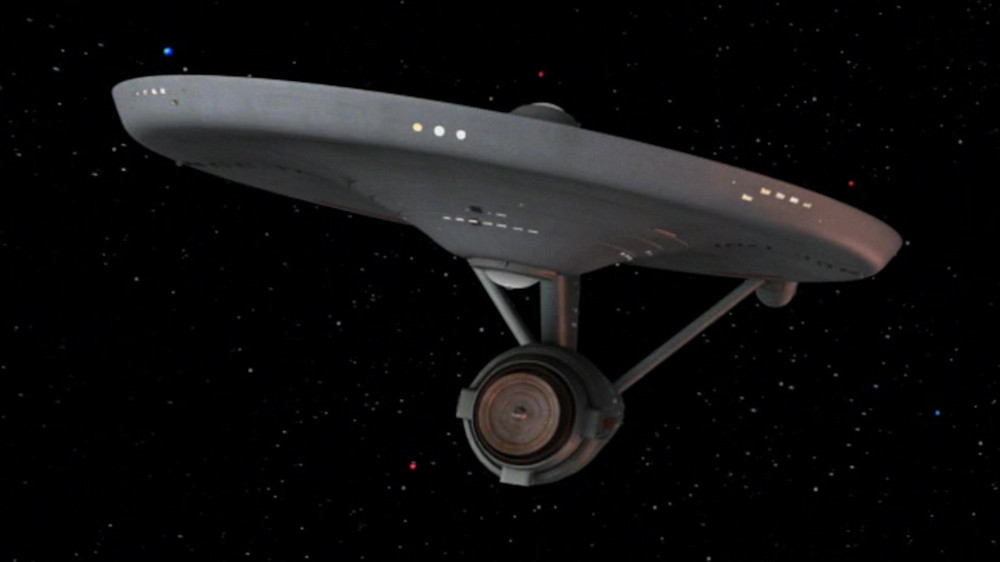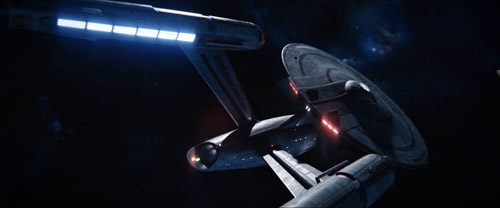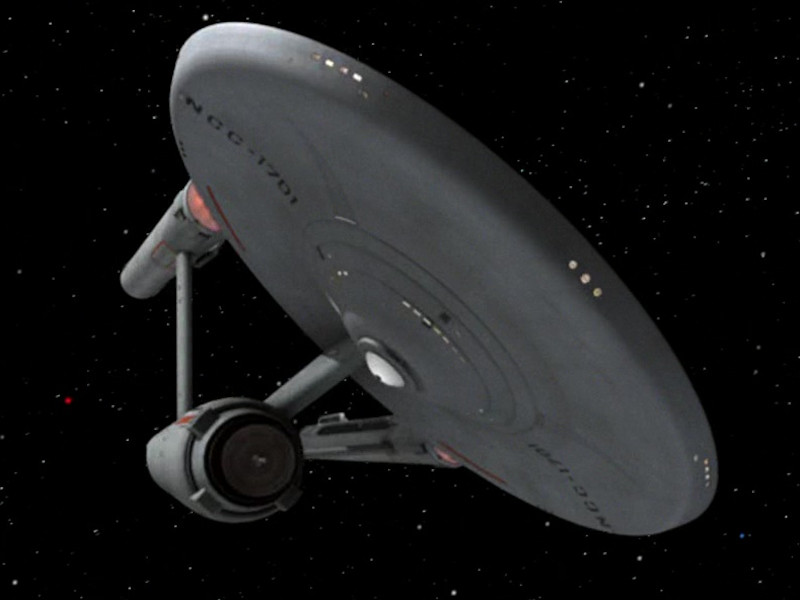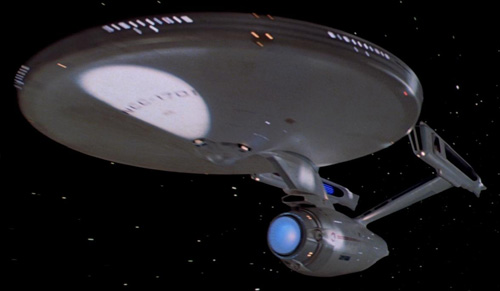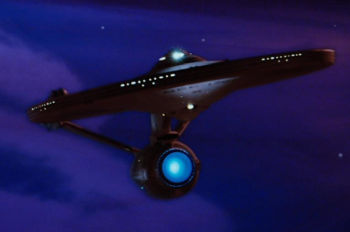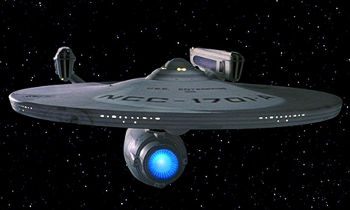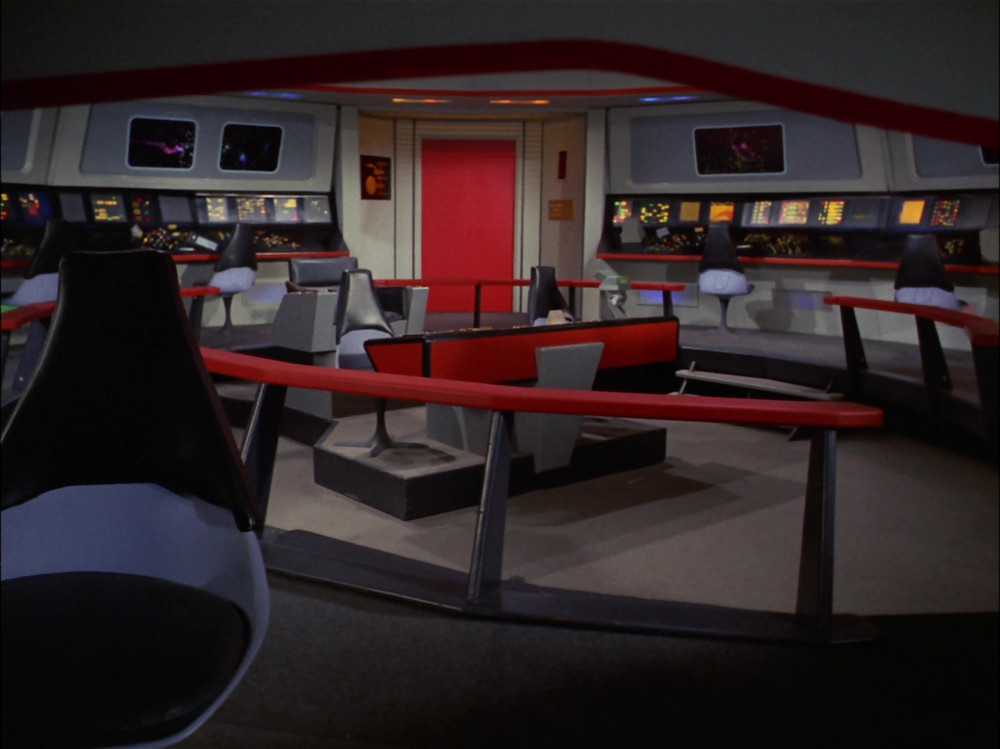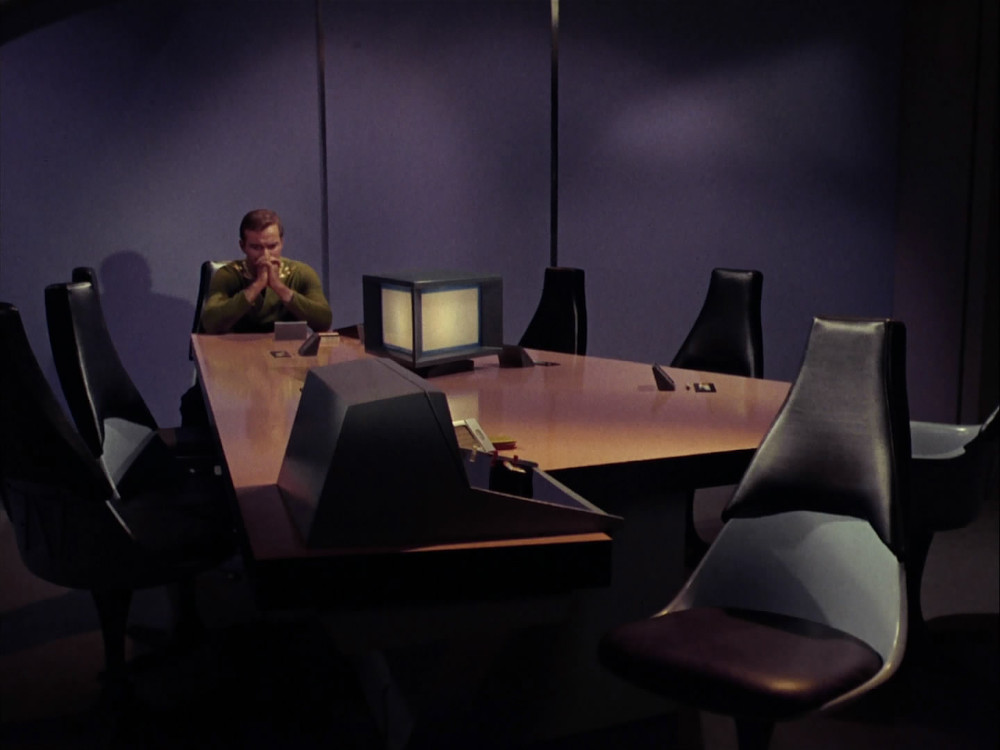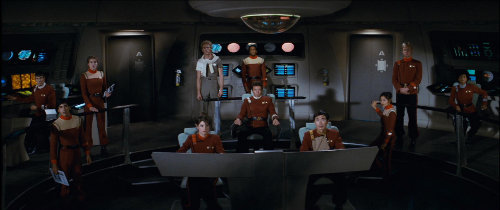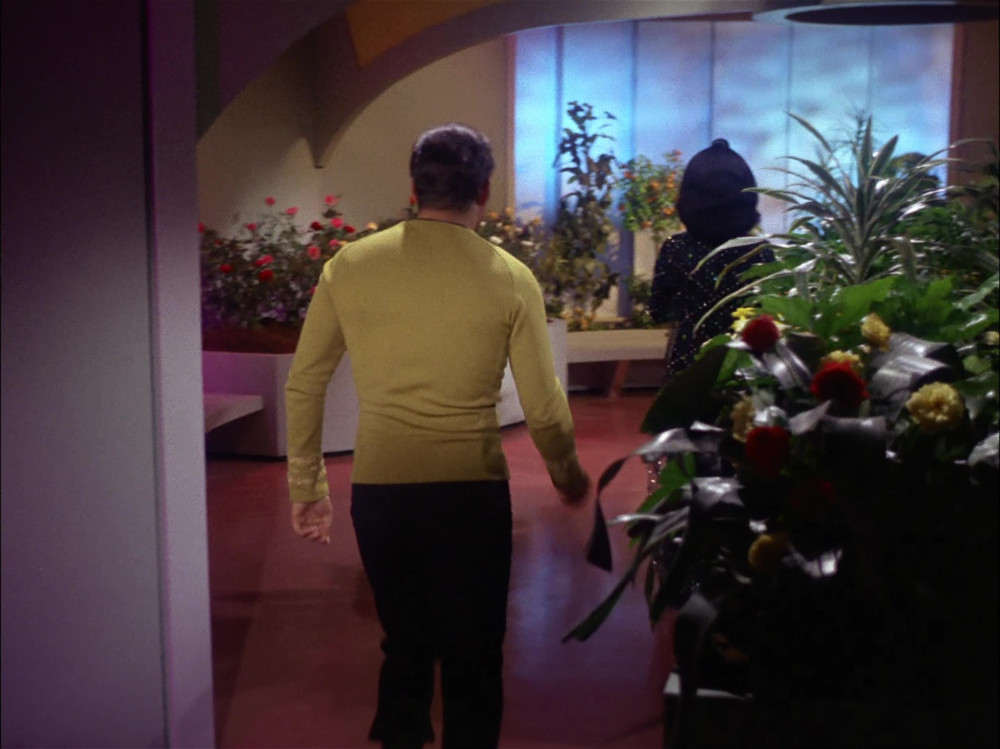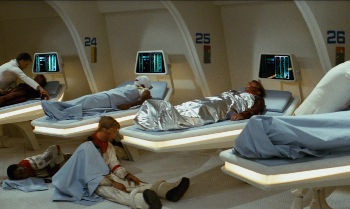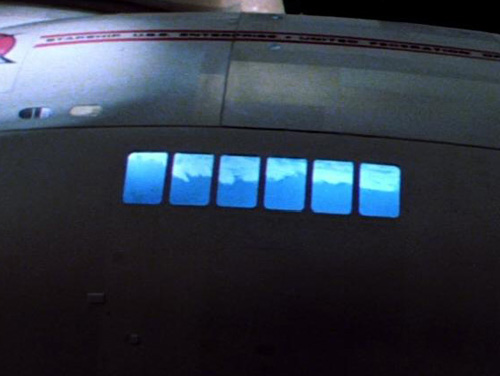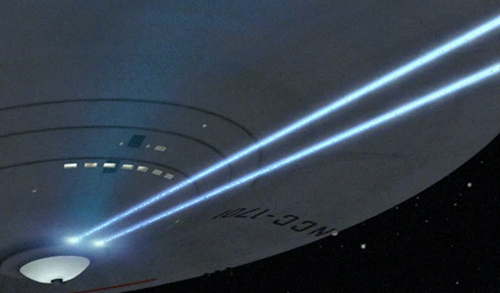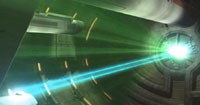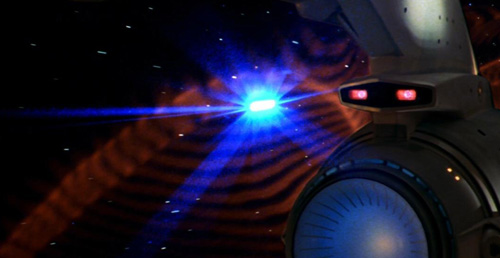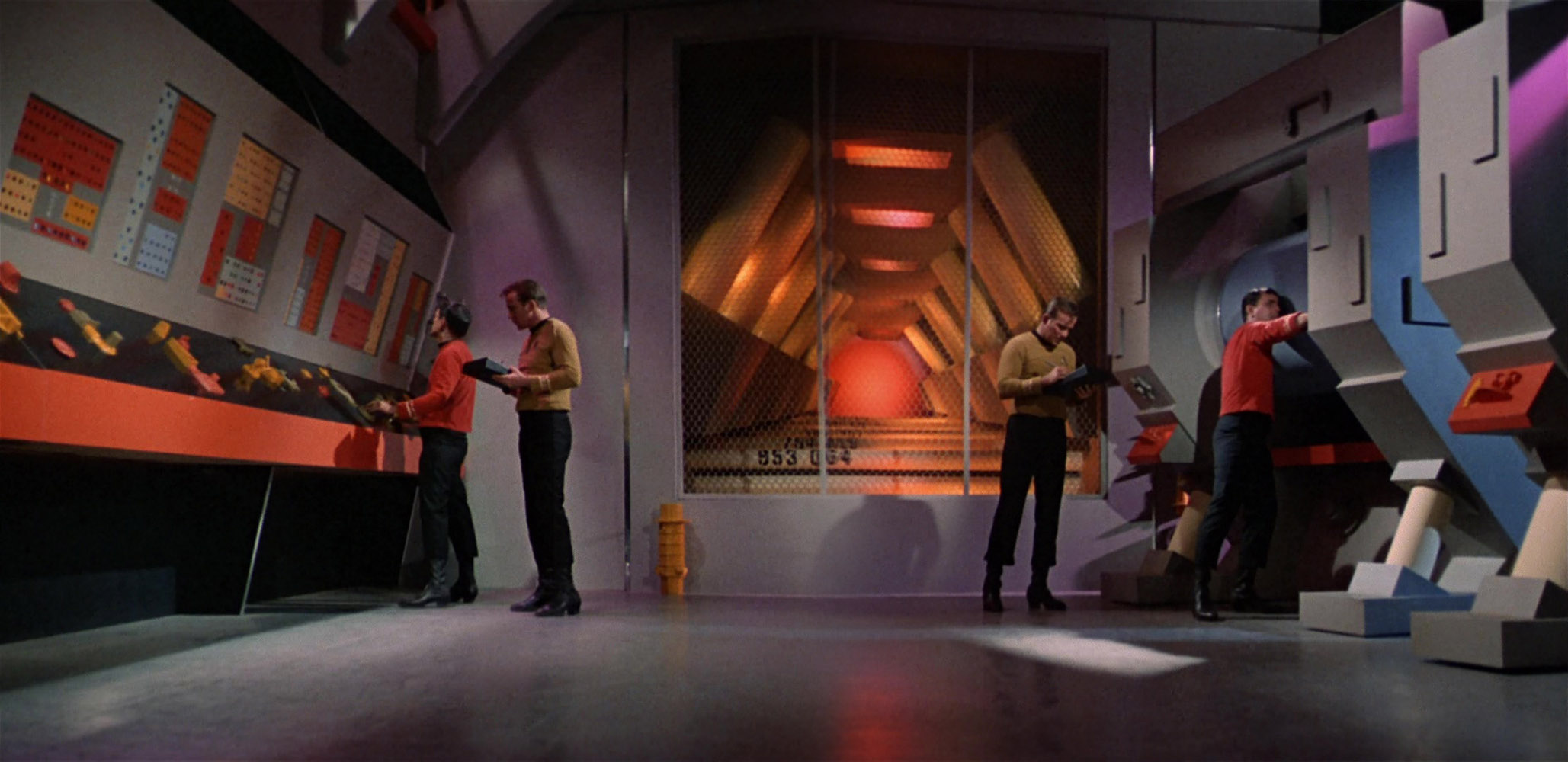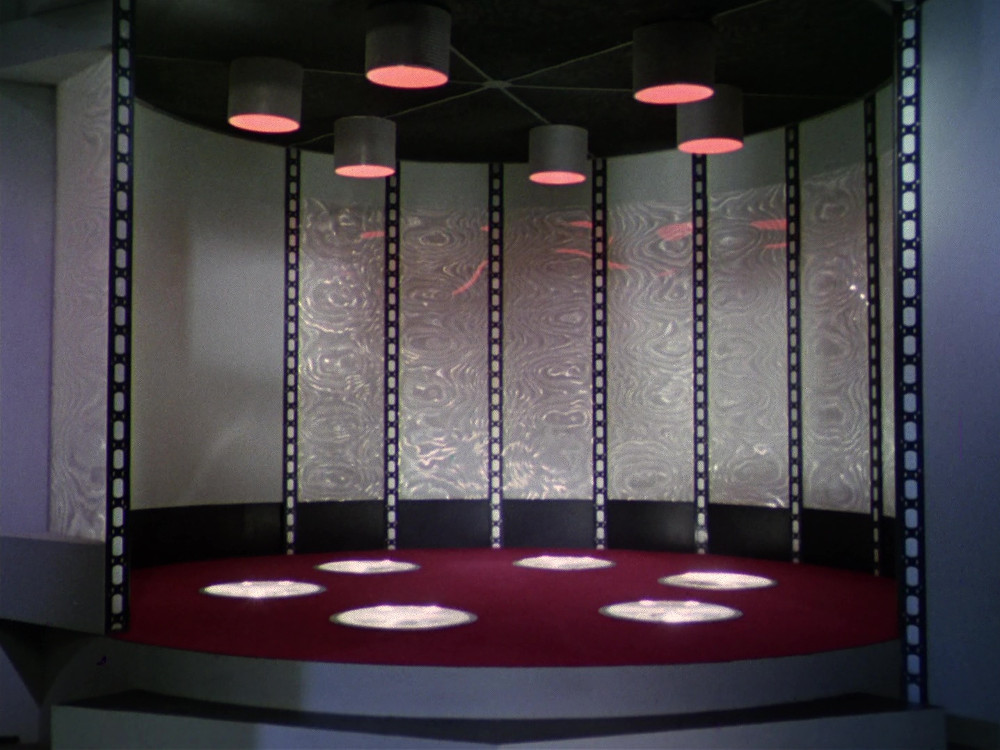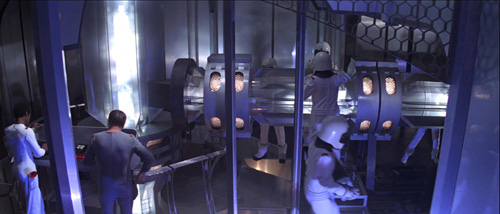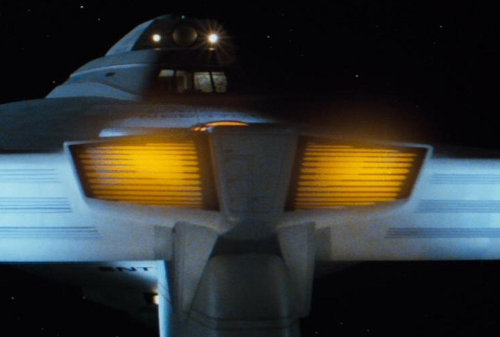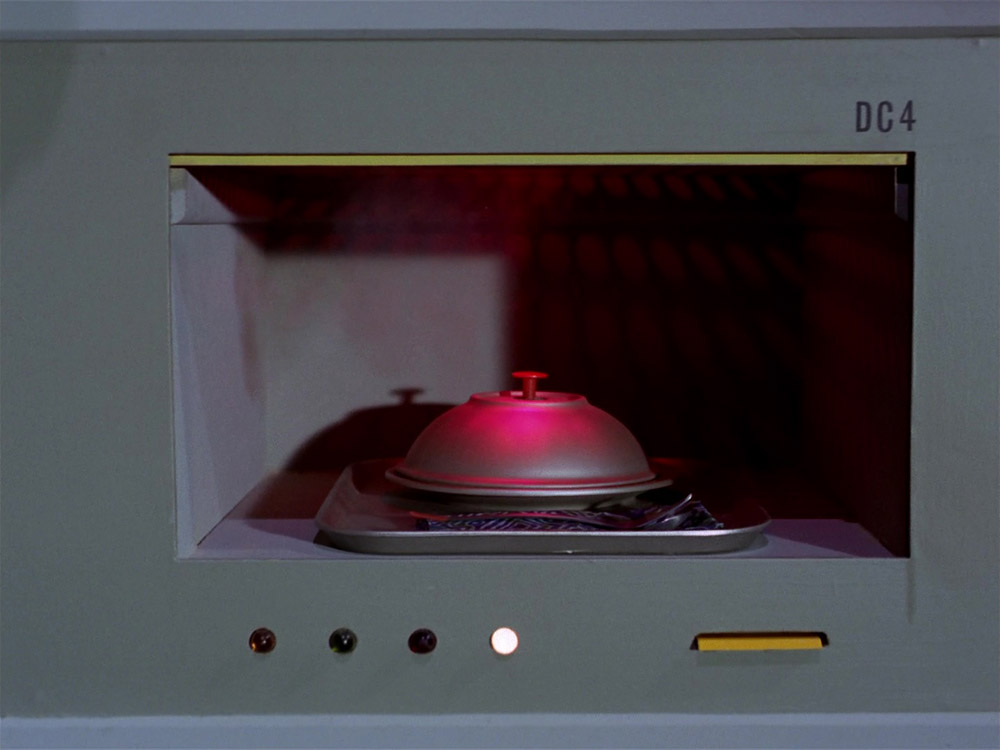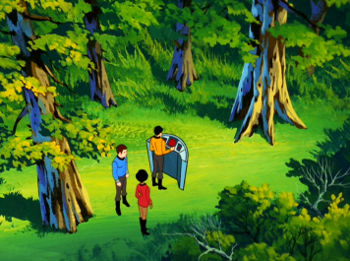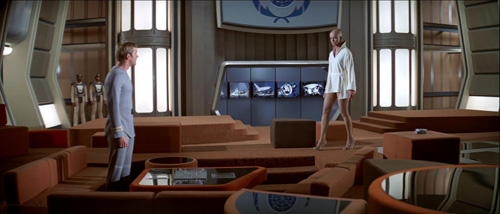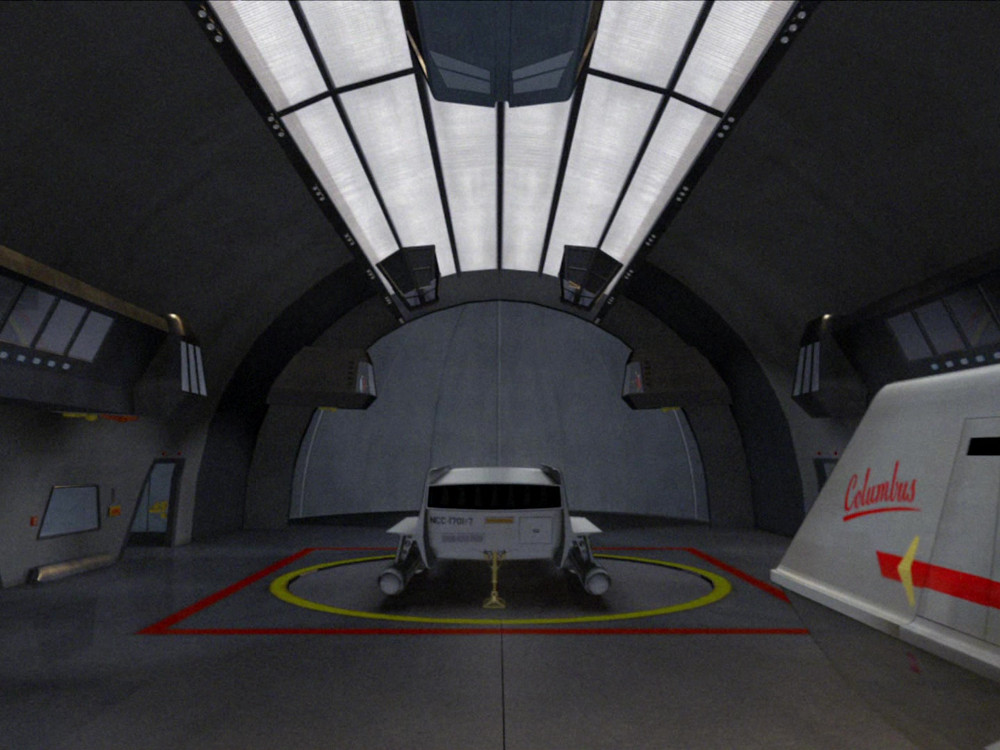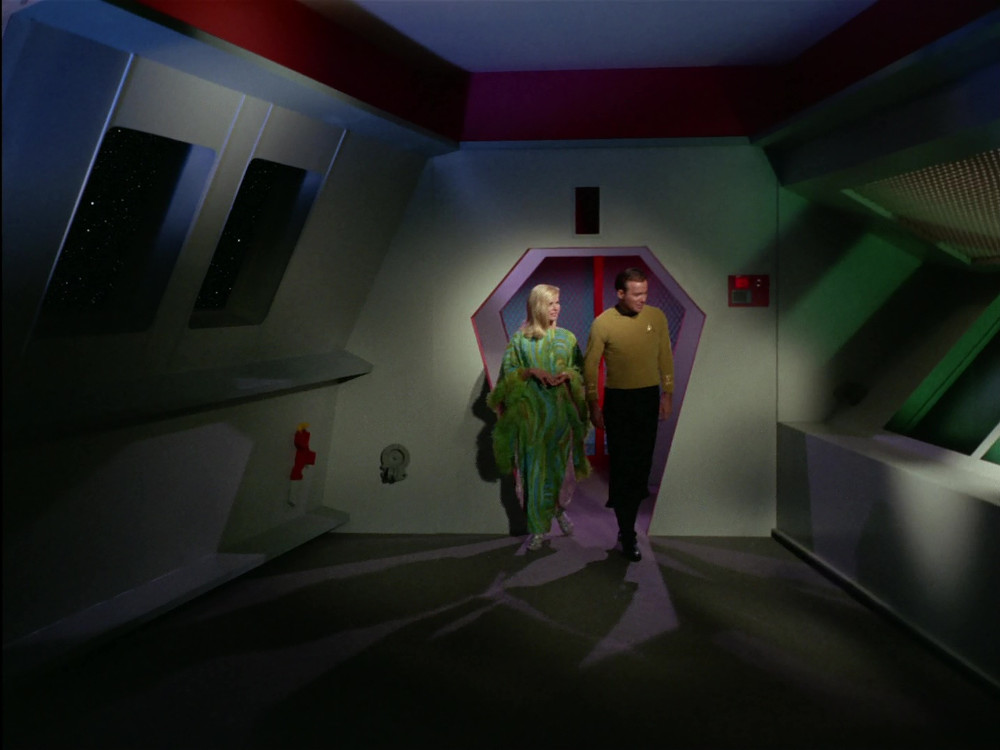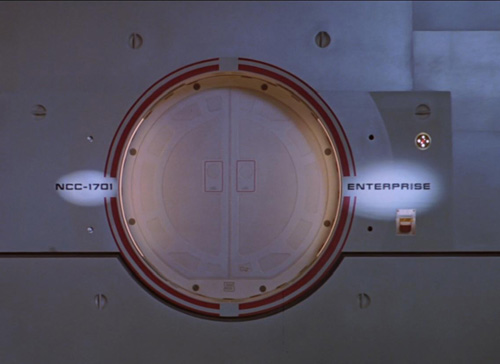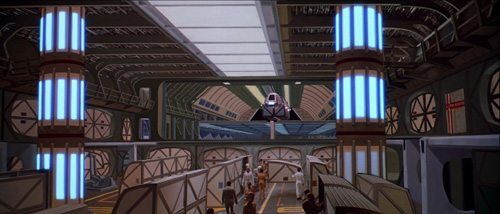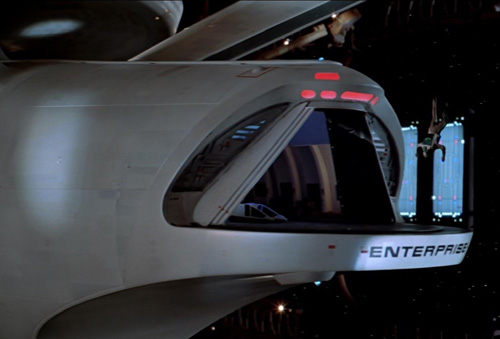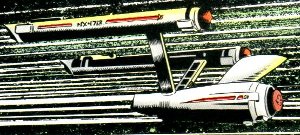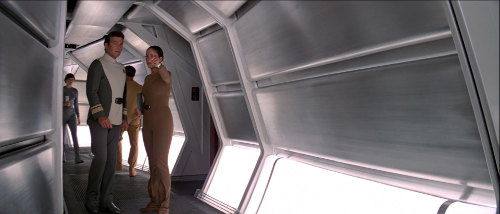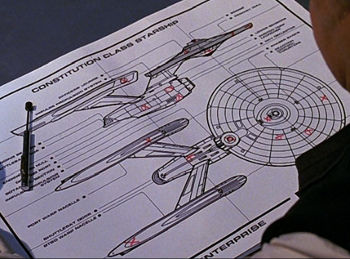Difference between revisions of "Constitution class"
| (91 intermediate revisions by the same user not shown) | |||
| Line 1: | Line 1: | ||
| − | + | {{DISPLAYTITLE:''Constitution'' class}} | |
| − | + | {{MyriadConstitutionClass}} | |
| − | {| | + | {{ImageInfoBox2|name=''Constitution'' class|file=constitution_class-tos05.jpg|caption=''Constitution'' class ({{TOS06}})}} |
| − | + | {{TableRow|title=Commissioned|data=[[Reference Stardate|RSD]] [[2245#January|1/8801 (Jan 2245)]]}} | |
| − | + | {{TableRow|title=Decommissioned|data=[[Reference Stardate|RSD]] [[2320#October|2/5710 (Oct 2320)]]}} | |
| − | + | {{TableRow|title=First Appearance|data={{TOS06}} ([[1966 (Production)#SEP08|8 Sep 1966]])}} | |
| − | + | {{TableRow|title=Advertising|data={{AmazonLink}} | |
| − | + | {{AmazonDSCBD}} | |
| − | + | {{AmazonSTKBD}} | |
| − | + | {{AmazonSNWBD}} | |
| − | | | + | }} |
| − | + | |}</div> | |
| − | | | + | {{InfoBox|boxwidth=30%|float=left|name=Mk I Specifications<ref name="FASA2302E2"/>}} |
| − | + | {{TableRow|title=Commissioned|data=[[Chronology: 2245|2245]]<ref name="ENT95"/>}} | |
| − | + | {{TableRow|title=Number Constructed|data=13}} | |
| − | | | + | {{TableRow|title=Length|data=290[[meter|m]]}} |
| − | | | + | {{TableRow|title=Width|data=127[[meter|m]]}} |
| − | + | {{TableRow|title=Height|data=73[[meter|m]]}} | |
| − | + | {{TableRow|title=Decks|data=23<ref name="STBP"/>}} | |
| − | | | + | {{TableRow|title=Mass|data=162,425[[ton#Metric Ton|mt]]}} |
| − | | | + | {{TableRow|title=Cargo Capacity|data=19,000[[ton#Metric Ton|mt]]}} |
| − | + | {{TableRow|title=Transporters|data=Personnel: 4<br/>Emergency: 5<br/>Cargo: 2}} | |
| − | | | + | {{TableRow|title=Shuttlecraft|data=10}} |
| − | + | {{TableRow|title=Crew|data=203<ref name="TOS00"/>}} | |
| − | | | + | {{TableRow|title=Passengers|data=80}} |
| − | + | {{TableRow|title=Evacuation Limit|data=Unknown}} | |
| − | + | {{TableRow|title=Velocity|data=Cruising: Warp 6<br/>Emergency: Warp 8 for 12 hours}} | |
| − | + | {{TableRow|title=Weapons|data=6 [[phase cannons|FL-6 Phase Cannons]] in 3 banks<br/>2 torpedo tubes<ref name="FASA2302E2"/> with 100 [[photon torpedo|Photon Torpedoes]]<ref name="LUG45000"/>}} | |
| − | + | |}</div> | |
| − | | | + | In [[Chronology: 2235|2235]], [[Starfleet]] decided that, to better expand and protect the [[United Federation of Planets|Federation]] as a whole, a more rugged and multipurpose exploration vessel was needed.<ref name="ModiphiusCore"/> Authorized under the [[Starfleet Appropriations#Stardate 0965|Starfleet Appropriation of Stardate 0965]],<ref name="SFTM"/> the design that resulted would impact the designs of dozens of later classes of starships.<ref name="ModiphiusCore"/> Construction on the ''Constitution'' class<ref name="TOS42"/> cruiser began at the [[San Francisco Fleet Yards]] on [[Reference Stardate]] [[Chronology: 2239#September|1/8209 (September 2239)]],<ref name="FASA2218A"/> and the class first entered service in [[Chronology: 2245|2245]].<ref name="LUG45000"/><ref name="ENT96"/> The most renowned vessels of their time, ''Constitution'' class cruisers performed their duties to perfection for nearly a century.<ref name="FASA2012"/> An integral part of [[Starfleet]]'s buildup during "[[The Great Awakening]],"<ref name="FASA2302E2"/> the class also distinguished itself during the [[Klingon War (23rd Century)|Klingon War]].<ref name="FASA2218A"/> |
| − | | | ||
| − | |||
| − | |||
| − | | | ||
| − | |||
| − | | | ||
| − | |||
| − | | | ||
| − | |||
| − | | | ||
| − | | | ||
| − | |||
| − | |||
| − | | | ||
| − | |||
| − | | | ||
| − | |||
| − | | | ||
| − | |||
| − | | | ||
| − | |||
| − | | | ||
| − | | | ||
| − | |||
| − | | | ||
| − | |||
| − | | | ||
| − | |||
| − | |||
| − | |||
| − | |||
| − | | | ||
| − | |||
| − | |||
| − | | | ||
| − | |||
| − | |||
| − | | | ||
| − | |||
| − | | | ||
| − | | | ||
| − | |||
| − | | | ||
| − | |||
| − | |||
| − | |||
| − | | | ||
| − | | | ||
| − | |||
| − | |||
| − | | | ||
| − | | | ||
| − | | | ||
| − | |||
| − | |||
| − | |||
| − | |||
| − | |||
| − | |||
| − | |||
| − | |||
| − | |||
| − | |||
| − | |||
| − | |||
| − | |||
| − | |||
| − | |||
| − | |||
| − | |||
| − | |||
| − | |||
| − | |||
| − | |||
| − | |||
| − | |||
| − | |||
| − | [[ | + | Originally, the class was intended to be much smaller, similar to the [[Daedalus class|''Daedalus'']] and [[Ranger class (2215)|''Ranger'']] classes that came before it, but a shift in design philosophies and the result of decades of research showed that a larger design could be feasible.<ref name="Decipher4"/> The original construction contract called for thirteen vessels to be built, which would serve as cruisers with complete research facilities, capable of operating on five-year research and exploration missions.<ref name="SFTM"/> The prototype [[U.S.S. Constitution NCC-1700|U.S.S. ''Constitution'' NCC-1700]], commissioned on Reference Stardate [[Chronology: 2245#January|1/8801.04]] (04 January<ref name="FASA2218A"/> 2245,<ref name="LUG45000"/>) was followed by a new ship each month thereafter: the [[U.S.S. Enterprise NCC-1701|U.S.S. ''Enterprise'' NCC-1701]] on Reference Stardate [[Chronology: 2245#February|1/8802 (February 2245)]], the [[U.S.S. Constellation NCC-1017|U.S.S. ''Constellation'' NCC-1017]] on Reference Stardate [[Chronology: 2245#March|1/8803 (March 2245)]], the [[U.S.S. Intrepid NCC-1631|U.S.S. ''Intrepid'' NCC-1631]] on Reference Stardate [[Chronology: 2245#April|1/8804 (April 2245)]], the [[U.S.S. Republic NCC-1371|U.S.S. ''Republic'' NCC-1371]] on Reference Stardate [[Chronology: 2245#May|1/8805 (May 2245)]], and the [[U.S.S. Farragut NCC-1647|U.S.S. ''Farragut'' NCC-1647]] on Reference Stardate [[Chronology: 2245#June|1/8806 (June 2245)]].<ref name="FASA2302E2"/> These first five vessels spent the next two years undergoing shakedown trials,<ref name="FASA2302E2"/> while the remaining seven vessels of the initial authorization were built and commissioned over the next five years, ending with the [[U.S.S. Hood NCC-1703|U.S.S. Hood NCC-1703]] on Reference Stardate [[Chronology: 2250#July|1/9307 (July 2250)]].<ref name="FASA2302E2"/> By [[Chronology: 2266|2266]], only twelve of the original thirteen ships were still in existence.<ref name="TOS12"/> |
| − | |||
| − | |||
| − | |||
| − | |||
| − | |||
| − | |||
| − | |||
| − | |||
| − | |||
| − | |||
| − | |||
| − | |||
| − | |||
| − | |||
| − | |||
| − | |||
| − | |||
| − | |||
| − | |||
| − | |||
| − | |||
| − | |||
| − | |||
| − | |||
| − | |||
| − | |||
| − | |||
| − | |||
| − | |||
| − | |||
| − | |||
| − | |||
| − | |||
| − | |||
| − | |||
| − | |||
| − | |||
| − | |||
| − | |||
| − | |||
| − | |||
| − | |||
| − | |||
| − | |||
| − | | | ||
| − | |||
| − | |||
| − | |||
| − | |||
| − | |||
| − | |||
| − | |||
| − | |||
| − | |||
| − | |||
| − | |||
| − | |||
| − | |||
| − | |||
| − | |||
| − | |||
| − | |||
| − | |||
| − | |||
| − | |||
| − | |||
| − | |||
| − | |||
| − | |||
| − | |||
| − | |||
| − | |||
| − | |||
| − | |||
| − | |||
| − | |||
| − | |||
| − | |||
| − | |||
| − | |||
| − | | | ||
| − | |||
| − | |||
| − | |||
| − | |||
| − | |||
| − | |||
| − | |||
| − | |||
| − | |||
| − | |||
| − | |||
| − | |||
| − | |||
| − | |||
| − | |||
| − | |||
| − | |||
| − | |||
| − | |||
| − | |||
| − | |||
| − | |||
| − | |||
| − | | | ||
| − | |||
| − | |||
| − | |||
| − | |||
| − | |||
| − | |||
| − | |||
| − | |||
| − | |||
| − | |||
| − | |||
| − | |||
| − | |||
| − | |||
| − | |||
| − | |||
| − | ''Constitution'' class | + | A multirole deep-space exploration cruiser, the ''Constitution'' class was able to project a [[United Federation of Planets|Federation]] presence further than ever before. The class included a number of enhancements not found on other classes of the era. Lavish accommodations allowed for the performance of diplomatic and courier missions, while an abundance of scientific laboratories and personnel made the class a superb exploratory and scientific platform. A more modular design allowed the rapid replacement of components and the varying of payloads at a moment's notice, as well as easy upgrades during a vessel's operational lifetime, as opposed to lengthy overhauls that kept other classes in spacedock.<ref name="Decipher4"/> |
| + | {{Clear}} | ||
| + | ==''Bonhomme Richard''== | ||
| + | {{InfoBox|boxwidth=30%|float=left|name=''Bonhomme Richard'' Specifications<ref name="SFTM"/>}} | ||
| + | {{TableRow|title=Commissioned|data=c.[[Chronology: 2250#December|Dec 2250]]<ref name="FASA2218A"/>}} | ||
| + | {{TableRow|title=Number Constructed|data=17}} | ||
| + | {{TableRow|title=Length|data=288.6[[meter|m]]}} | ||
| + | {{TableRow|title=Width|data=127.1[[meter|m]]}} | ||
| + | {{TableRow|title=Height|data=72.6[[meter|m]]}} | ||
| + | {{TableRow|title=Decks|data=23}} | ||
| + | {{TableRow|title=Mass|data=190,000[[ton#Metric Ton|mt]]}} | ||
| + | {{TableRow|title=Crew|data=203<ref name="TOS00"/>}} | ||
| + | {{TableRow|title=Velocity|data=Cruising: Warp 6<br/>Emergency: Warp 8 for 12 hours}} | ||
| + | {{TableRow|title=Weapons|data=6 [[phasers|Phasers]] in 3 banks<br/>2 torpedo tubes}} | ||
| + | |}</div> | ||
| + | Authorized by the [[Starfleet Appropriations#Stardate 3220|Starfleet Appropriation of Stardate 3220]], the ''Bonhomme Richard'' type was a subclass of the ''Constitution'' class<ref name="SFTM"/> first produced only five years earlier.<ref name="FASA2218A"/> Largely identical to the original thirteen ''Constitution'' class vessels, the ''Bonhomme Richard'' subclass featured several upgrades,<ref name="SFTM"/> including [[phasers]] in place of [[phase cannons]],<ref name="TOS01"/><ref name="DSC01"/> which increased the mass of the vessels by several thousand [[ton#Metric Ton|metric tons]].<ref name="FASA2302E2"/><ref name="SFTM"/> Following the initial order of sixteen vessels, an additional four were approved by the [[Starfleet Appropriations#Stardate 4444|Starfleet Appropriation of Stardate 4444]],<ref name="SFTM"/> but only one of those was constructed.<ref name="BonhommeRichard">Three of the vessels indicated as replacements for lost vessels, the U.S.S. ''Constellation'' II NCC-1728, U.S.S. ''Farragut'' II NCC-1729, and U.S.S. ''Intrepid'' II NCC-1730, have commissioning dates of late 2251, predating the destruction of their namesakes by more than a decade. This is clearly impossible, and these vessels are instead listed as not being constructed, with two later being constructed as ''Enterprise'' subclass vessels instead.</ref> | ||
| + | {{Clear}} | ||
| + | ==''Achernar'' and ''Tikopai''== | ||
| + | {{ImageInfoBox2|name=''Achernar'' and ''Tikopai'' Specifications<ref name="SFTM"/>|file=constitution_class_aft-dsc28.jpg|caption=''Constitution'' class ({{DSC28}})}} | ||
| + | {{TableRow|title=Commissioned|data=[[Chronology: 2252#September|1/9509 (Sep 2252)]]<ref name="FASA2218A"/>}} | ||
| + | {{TableRow|title=Number Constructed|data=68}} | ||
| + | {{TableRow|title=Length|data=288.6[[meter|m]]}} | ||
| + | {{TableRow|title=Width|data=127.1[[meter|m]]}} | ||
| + | {{TableRow|title=Height|data=72.6[[meter|m]]}} | ||
| + | {{TableRow|title=Decks|data=23}} | ||
| + | {{TableRow|title=Mass|data=190,000[[ton#Metric Ton|mt]]}} | ||
| + | {{TableRow|title=Crew|data=203<ref name="TOS00"/>}} | ||
| + | {{TableRow|title=Velocity|data=Cruising: Warp 6<br/>Emergency: Warp 8 for 12 hours}} | ||
| + | {{TableRow|title=Weapons|data=6 [[phasers|Phasers]] in 3 banks<br/>2 torpedo tubes}} | ||
| + | |}</div> | ||
| + | Authorized by the [[Starfleet Appropriations#Stardate 5930|Starfleet Appropriation of Stardate 5930]], the ''Achenar'' and ''Tikopai'' subclasses came into service with the commissioning of the [[U.S.S. Achernar NCC-1732|U.S.S. ''Achernar'' NCC-1732]] and the [[U.S.S. Tikopai NCC-1800|U.S.S. ''Tikopai'' NCC-1800]]<ref name="SFTM"/> on [[Reference Stardate]] [[Chronology: 2252#September|1/9509 (September 2252)]].<ref name="FASA2218A"/> The [[warp drive|warp engine]] [[nacelles]] were reinforced and featured additional hull plating, giving them a bulkier outline, and the pylons connecting the nacelles to the secondary hull were strengthened with a thicker, dual-strut arrangement.<ref name="DSC15"/> The ''Achernar'' and ''Tikopai'' subclasses were prone to systems failures,<ref name="DSC16"/> which were blamed in part on incompatiblities with the new [[holograms|holographic]] communications systems and other ship's systems.<ref name="DSC19"/> | ||
| − | + | A total of 68 new ''Achernar'' type and 44 new ''Tikopai'' type vessels were authorized,<ref name="SFTM"/> and the subclasses saw extensive combat<ref name="FASA2218A"/> in the [[Klingon War (23rd Century)|Klingon War]] of [[Chronology: 2256|2256]]-[[Chronology: 2257|2257]].<ref name="DSC02"/><ref name="DSC15"/> The ''Constitution'' class distinguished itself in battle on multiple occasions, garnering the nickname "The Queens of Starfleet" for the class. After-action reports continued to show the class to be superior to any other in the fleet.<ref name="FASA2302E2"/> Many that survived the war were later destroyed in weapons testing and as part of [[Starfleet]]'s postwar demilitarization program. Some remained in service and were refit to other class variants.<ref name="FASA2218A"/> | |
| − | + | {{Clear}} | |
| − | + | ==Mark II== | |
| − | + | {{ImageInfoBox2|float=left|name=Mk II Specifications<ref name="FASA2302E2"/>|file=constitution_class-tos-10.jpg|caption=''Constitution'' class ({{TOS11}})}} | |
| − | + | {{TableRow|title=Commissioned|data=[[Chronology: 2257#January|1/9901 (Jan 2257)]]}} | |
| − | + | {{TableRow|title=Number Constructed|data=28}} | |
| − | + | {{TableRow|title=Length|data=290[[meter|m]]}} | |
| − | + | {{TableRow|title=Width|data=127[[meter|m]]}} | |
| − | + | {{TableRow|title=Height|data=73[[meter|m]]}} | |
| − | + | {{TableRow|title=Decks|data=23<ref name="STBP"/>}} | |
| − | + | {{TableRow|title=Mass|data=162,600[[ton#Metric Ton|mt]]}} | |
| − | + | {{TableRow|title=Cargo Capacity|data=19,500[[ton#Metric Ton|mt]]}} | |
| − | + | {{TableRow|title=Transporters|data=Personnel: 4<br/>Emergency: 5<br/>Cargo: 2}} | |
| − | + | {{TableRow|title=Shuttlecraft|data=10}} | |
| − | + | {{TableRow|title=Crew|data=430<ref name="TOS07"/>}} | |
| − | + | {{TableRow|title=Passengers|data=60}} | |
| − | + | {{TableRow|title=Velocity|data=Cruising: Warp 6<br/>Emergency: Warp 8 for 12 hours}} | |
| − | + | {{TableRow|title=Weapons|data=6 [[phasers|FH-3 Type IV Phasers]] in 3 banks<br/>2 torpedo tubes<ref name="FASA2302E2"/> with 100 [[photon torpedo|Photon Torpedoes]]<ref name="LUG45000"/>}} | |
| − | + | |}</div> | |
| − | + | The Mark II specifications were introduced during the [[Klingon War (23rd Century)|Klingon War]] on [[Reference Stardate]] [[Chronology: 2257#January|1/9901 (January 2257)]] with the commissioning of the [[U.S.S. Bismarck NCC-1704|U.S.S. ''Bismarck'' NCC-1704]].<ref name="FASA2302E2"/> While the class originally mounted the Tesla-class<ref name="LUG45000"/> FL-6<ref name="FASA2302E2"/> [[phase cannons]],<ref name="ENT12"/><ref name="DSC01"/> known colloquially as "Lasers,"<ref name="TOS00"/><ref name="Lasers">The ship's armaments were referred to as "lasers" in "[[The Cage (Episode)|The Cage]]," then as "phasers" throughout the rest of the series and spinoffs; this was due to the properties of lasers being a known quantity in reality, which could potentially hinder future story writing, so a new term was coined. ''[[Star Trek: Enterprise]]'' established that the energy weapons in that series were called "phase cannons," a technological precursor to phasers. In ''[[Star Trek: Discovery]],'' the [[U.S.S. Shenzhou NCC-1227|U.S.S. ''Shenzhou'' NCC-1227]], a contemporary of the ''Enterprise,'' was equipped with both phasers and phase cannons. This issue is reconciled by stating that the ship was initially fitted with phase cannons, which were colloquially known as "lasers," and subsequently upgraded in later refits to phasers.</ref> the Mark II specifications introduced the FH-3 [[Phaser]] emplacements,<ref name="FASA2302E2"/> which were later reclassified as [[phasers#Type IV|Type IV Phasers]].<ref name="Decipher2"/> ''Constitution'' class starships used [[duotronics|duotronic]] computers, based on designs developed by [[doctor|Dr.]] [[Daystrom, Richard|Richard Daystrom]] in [[Chronology: 2243|2243]],<ref name="TOS53"/> and mounted the most powerful engines available,<ref name="LUG45000"/> based on the revolutionary designs of Dr. [[Marvick, Lawrence|Lawrence Marvick]].<ref name="TOS62"/> The class also mounted two Mark 12 indirect-fire torpedo tubes<ref name="Decipher4"/> and Type I [[photon torpedo|photon torpedoes]],<ref name="Decipher2"/> which provided a sizable tactical advantage over older [[spatial torpedo|spatial]]<ref name="ENT01"/> and [[photonic torpedo|photonic torpedoes]].<ref name="ENT52"/> These torpedo launchers were also capable of firing long-range probes, enhancing the ''Constitution'' class's sensor and exploration capabilities.<ref name="Decipher4"/> The Mark II design also introduced newer, more powerful [[shields]],<ref name="FASA2302E2"/> and crew capacity was expanded from 203<ref name="TOS00"/> to 435,<ref name="TOS07"/> following the invention of an improved [[food synthesizer]].<ref name="LUG45000"/> By [[Chronology: 2264#October|2/0510 (October 2263)]], the refitting was complete, and the ''Constitution'' class remained the most advanced starship of its time.<ref name="FASA2302E2"/> | |
| − | + | {{Clear}} | |
| − | + | ==Mark III== | |
| − | + | {{InfoBox|boxwidth=30%|name=Mk III Specifications<ref name="STBP"/>}} | |
| − | + | {{TableRow|title=Commissioned|data=[[Chronology: 2270#Feb|2/1202 (Feb 2270)]]}} | |
| − | + | {{TableRow|title=Number Constructed|data=6}} | |
| − | + | {{TableRow|title=Length|data=288.646[[meter|m]]}} | |
| − | + | {{TableRow|title=Width|data=127.102[[meter|m]]}} | |
| − | + | {{TableRow|title=Height|data=72.6[[meter|m]]}} | |
| − | + | {{TableRow|title=Decks|data=23}} | |
| − | + | {{TableRow|title=Mass|data=190,000[[ton#Metric Ton|mt]]}} | |
| − | + | {{TableRow|title=Cargo Capacity|data=19,500[[ton#Metric Ton|mt]]<ref name="FASA2302E2"/>}} | |
| − | + | {{TableRow|title=Transporters|data=Personnel: 4<br/>Emergency: 5<br/>Cargo: 2}} | |
| − | + | {{TableRow|title=Shuttlecraft|data=12}} | |
| − | + | {{TableRow|title=Crew|data=435<ref name="LUG45000"/>}} | |
| − | + | {{TableRow|title=Passengers|data=235<ref name="LUG45000"/>}} | |
| − | + | {{TableRow|title=Evacuation Limit|data=3,500<ref name="LUG45000"/>}} | |
| − | + | {{TableRow|title=Velocity|data=Cruising: Warp 6<ref name="SFTM"/><br/>Emergency: Warp 8<ref name="SFTM"/>}} | |
| − | + | {{TableRow|title=Weapons|data=6 [[phasers|FH-3 Type IV Phasers]]<ref name="FASA2302E2"/><ref name="Decipher4"/> in 3 banks<br/>2 torpedo tubes with 100 [[photon torpedo|Photon Torpedoes]]<ref name="LUG45000"/>}} | |
| − | + | |}</div> | |
| − | |||
| − | |||
| − | |||
| − | |||
| − | |||
| − | |||
| − | |||
| − | |||
| − | |||
| − | |||
| − | |||
| − | |||
| − | |||
| − | |||
| − | |||
| − | |||
| − | |||
| − | |||
| − | |||
| − | |||
| − | |||
| − | |||
| − | |||
| − | |||
| − | |||
| − | |||
| − | |||
| − | |||
| − | |||
| − | |||
| − | |||
| − | |||
| − | |||
| − | |||
| − | |||
| − | |||
| − | |||
| − | |||
| − | |||
| − | |||
| − | |||
| − | |||
| − | |||
| − | |||
| − | |||
| − | |||
| − | |||
| − | |||
| − | |||
| − | |||
| − | == | + | On [[Reference Stardate]] [[Chronology: 2259#March|2/0104 (March 2259)]], the [[warp nacelle#FWF|FWF-1]] [[warp drive]] was brought into the inventory. All ''Constitution class'' ships were recalled to be refit as Mark IIIs, and the Mark III specifications were introduced on Reference Stardate [[Chronology: 2260#March|2/0203 (March 2260)]] with the refit of the [[U.S.S. Enterprise NCC-1701|U.S.S. ''Enterprise'' NCC-1701]]. By Reference Stardate [[Chronology: 2263#October|2/0510 (October 2263)]], the refits were complete, and the ''Constitution'' class remained the most advanced starship of its time.<ref name="FASA2302E2"/> |
| + | {{Clear|value=left}} | ||
| + | {{Clear}} | ||
| + | ==Mark IV== | ||
| + | {{InfoBox|boxwidth=30%|float=left|name=Mk IV Specifications<ref name="FASA2302E2"/>}} | ||
| + | {{TableRow|title=Commissioned|data=[[Chronology: 2270#Feb|2/1202 (Feb 2270)]]}} | ||
| + | |}</div> | ||
| + | After the first successful test firing of the FP-5 [[photon torpedo]] system, [[Starfleet]] ordered that twelve ''Constitution'' class vessels be modified to fire it, as well as including more powerful [[impulse engine|impulse engines]] and [[shields|shield]] generators. The Mark IV specifications were introduced on [[Reference Stardate]] [[Chronology: 2270#February|2/1202 (February 2270)]] with the refit of the [[U.S.S. Discovery NCC-1798|U.S.S. ''Discovery'' NCC-1798]], [[U.S.S. Saratoga NCC-1720|U.S.S. ''Saratoga'' NCC-1720]], [[U.S.S. El Dorado NCC-1722|U.S.S. ''El Dorado'' NCC-1722]], and [[U.S.S. Kitty Hawk NCC-1754|U.S.S. ''Kitty Hawk'' NCC-1754]]. Though no new vessels were built to Mark IV specifications, the other eight ships were also refit by Reference Stardate [[Chronology: 2271#August|2/1308 (August 2271)]].<ref name="FASA2302E2"/> | ||
| + | |||
| + | {{Clear}} | ||
| + | ==''Enterprise''== | ||
| + | {{ImageInfoBox2|name=''Enterprise'' Specifications<ref name="FASA2302E2"/>|file=constitution_class-st01.jpg|caption=''Constitution'' class ({{ST01}})}} | ||
| + | {{TableRow|title=Commissioned|data=[[Chronology: 2273#April|2/1704 (Apr 2273)]]}} | ||
| + | {{TableRow|title=Number Constructed|data=26}} | ||
| + | {{TableRow|title=Length|data=302[[meter|m]]}} | ||
| + | {{TableRow|title=Width|data=131[[meter|m]]}} | ||
| + | {{TableRow|title=Height|data=74[[meter|m]]}} | ||
| + | {{TableRow|title=Decks|data=23<ref name="Decipher2"/>}} | ||
| + | {{TableRow|title=Mass|data=160,275[[ton#Metric Ton|mt]]}} | ||
| + | {{TableRow|title=Cargo Capacity|data=22,500[[ton#Metric Ton|mt]]}} | ||
| + | {{TableRow|title=Transporters|data=Personnel: 4<br/>Emergency: 4<br/>Cargo: 2}} | ||
| + | {{TableRow|title=Shuttlecraft|data=12}} | ||
| + | {{TableRow|title=Crew|data=412}} | ||
| + | {{TableRow|title=Passengers|data=60}} | ||
| + | {{TableRow|title=Velocity|data=Cruising: Warp 8<br/>Emergency: Warp 10}} | ||
| + | {{TableRow|title=Weapons|data=6 [[phasers#Type VII|FH-6 Type VII Phasers]]<ref name="FASA2302E2"/><ref name="Decipher2"/> in 3 banks<br/>2 torpedo tubes}} | ||
| + | |}</div> | ||
| + | On [[Stardate]] [[Chronology: 2270#7523|7523.2]] (7 April<ref name="MSG"/> 2270<ref name="VOY265"/>) the U.S.S. ''Enterprise'' returned to [[Earth]] orbit following its last, historic five-year mission.<ref name="MSG"/> Although the decision had been made three months earlier to decommission and scrap the ''Enterprise,'' the ship had come to be seen as a symbol of Starfleet and the Federation. This swell of public opinion drove a motion in the [[Federation Council]] that led to a reversal of Starfleet's plans. The ''Enterprise,'' however, was still twenty-five years old; her systems were becoming outdated, and it soon became apparent that only a major refit could keep the ship at the forefront of the fleet.<ref name="MSG"/> What began as a simple refit to the Mark IV specifications<ref name="FASA2302E2"/> quickly evolved into a redesign of the entire vessel.<ref name="ST01"/> | ||
| + | |||
| + | {{Clear}} | ||
| + | ==''Enterprise'' Mark II== | ||
| + | {{ImageInfoBox2|float=left|name=''Enterprise'' Mk II Specifications<ref name="FASA2302E2"/>|file=constitution_class-st-02.jpg|caption=''Constitution'' class ({{ST02}})}} | ||
| + | {{TableRow|title=Commissioned|data=[[Chronology: 2280#January|2/1910 (Jan 2280)]]}} | ||
| + | {{TableRow|title=Number Constructed|data=19}} | ||
| + | {{TableRow|title=Length|data=302[[meter|m]]}} | ||
| + | {{TableRow|title=Width|data=131[[meter|m]]}} | ||
| + | {{TableRow|title=Height|data=74[[meter|m]]}} | ||
| + | {{TableRow|title=Decks|data=23<ref name="Decipher2"/>}} | ||
| + | {{TableRow|title=Mass|data=163,275[[ton#Metric Ton|mt]]}} | ||
| + | {{TableRow|title=Cargo Capacity|data=22,500[[ton#Metric Ton|mt]]}} | ||
| + | {{TableRow|title=Transporters|data=Personnel: 4<br/>Emergency: 4<br/>Cargo: 2}} | ||
| + | {{TableRow|title=Shuttlecraft|data=12}} | ||
| + | {{TableRow|title=Crew|data=416}} | ||
| + | {{TableRow|title=Passengers|data=60}} | ||
| + | {{TableRow|title=Velocity|data=Cruising: Warp 8<br/>Emergency: Warp 10}} | ||
| + | {{TableRow|title=Weapons|data=6 [[phasers#Type VII|FH-6 Type VII Phasers]]<ref name="FASA2302E2"/><ref name="Decipher2"/> in 3 banks<br/>2 torpedo tubes}} | ||
| + | |}</div> | ||
| + | The class was modified to house the FIF-1 [[impulse drive]] system, giving the Mark II specifications an additional 7% more operating power. The Mark II was introduced on [[Reference Stardate]] [[Chronology: |2/1910]] with the refit of the [[U.S.S. Graf Zeppelin NCC-1726|U.S.S. ''Graf Zeppelin'' NCC-1726]].<ref name="FASA2302E2"/> | ||
| + | |||
| + | {{Clear}} | ||
| + | ==''Enterprise'' Mark III== | ||
| + | {{ImageInfoBox2|name=''Enterprise'' Mk III Specifications<ref name="FASA2302E2"/>|file=enterprise_1701a-st-06.jpg|caption=''Constitution'' class ({{ST06}})}} | ||
| + | {{TableRow|title=Commissioned|data=[[Chronology: 2284#February|2/2102 (Feb 2284)]]}} | ||
| + | {{TableRow|title=Number Constructed|data=10}} | ||
| + | {{TableRow|title=Length|data=302[[meter|m]]}} | ||
| + | {{TableRow|title=Width|data=131[[meter|m]]}} | ||
| + | {{TableRow|title=Height|data=74[[meter|m]]}} | ||
| + | {{TableRow|title=Decks|data=23<ref name="Decipher2"/>}} | ||
| + | {{TableRow|title=Mass|data=171,008[[ton#Metric Ton|mt]]}} | ||
| + | {{TableRow|title=Cargo Capacity|data=22,500[[ton#Metric Ton|mt]]}} | ||
| + | {{TableRow|title=Transporters|data=Personnel: 4<br/>Emergency: 4<br/>Cargo: 2}} | ||
| + | {{TableRow|title=Shuttlecraft|data=12}} | ||
| + | {{TableRow|title=Crew|data=416}} | ||
| + | {{TableRow|title=Passengers|data=60}} | ||
| + | {{TableRow|title=Velocity|data=Cruising: Warp 8<br/>Emergency: Warp 10}} | ||
| + | {{TableRow|title=Weapons|data=8 [[phasers#Type VII|FH-11 Type VII Phasers]]<ref name="FASA2302E2"/><ref name="Decipher2"/> in 4 banks<br/>3 torpedo tubes}} | ||
| + | |}</div> | ||
| + | The Mark III specifications were introduced on [[Reference Stardate]] [[Chronology: 2284#February|2/2102 (February 2284)]] with the refit of the [[U.S.S. Kongo NCC-1710|U.S.S. ''Kongo'' NCC-1710]]. The Mark III mounted the FIF-2 [[impulse drive]] system, giving it 15% more power than the Mark I and 6% more power than the Mark II. The Mark III also included an additional bank of FH-11 [[phasers]] and an additional FP-4 torpedo launcher, with both systems providing additional firepower to the ship's aft, giving the class much needed protection.<ref name="FASA2302E2"/> | ||
| + | |||
| + | {{Clear}} | ||
| + | ==''Enterprise'' Mark IV== | ||
| + | {{InfoBox|boxwidth=30%|float=left|name=''Enterprise'' Mk IV Specifications<ref name="FASA2302E2"/>}} | ||
| + | {{TableRow|title=Commissioned|data=[[Chronology: 2285#December|2/2212 (Dec 2285)]]}} | ||
| + | {{TableRow|title=Number Constructed|data=50}} | ||
| + | {{TableRow|title=Length|data=322[[meter|m]]}} | ||
| + | {{TableRow|title=Width|data=131[[meter|m]]}} | ||
| + | {{TableRow|title=Height|data=78[[meter|m]]}} | ||
| + | {{TableRow|title=Decks|data=23<ref name="Decipher2"/>}} | ||
| + | {{TableRow|title=Mass|data=197,543[[ton#Metric Ton|mt]]}} | ||
| + | {{TableRow|title=Cargo Capacity|data=22,500[[ton#Metric Ton|mt]]}} | ||
| + | {{TableRow|title=Transporters|data=Personnel: 4<br/>Emergency: 4<br/>Cargo: 2 large, 2 small}} | ||
| + | {{TableRow|title=Shuttlecraft|data=12}} | ||
| + | {{TableRow|title=Crew|data=422}} | ||
| + | {{TableRow|title=Passengers|data=50}} | ||
| + | {{TableRow|title=Velocity|data=Cruising: Warp 10<br/>Emergency: Warp 14}} | ||
| + | {{TableRow|title=Weapons|data=8 [[phasers#Type VII|FH-11 Type VII Phasers]]<ref name="FASA2302E2"/><ref name="Decipher2"/> in 4 banks<br/>4 torpedo tubes}} | ||
| + | |}</div> | ||
| + | Following the advances in [[warp drive]] technology that emerged from the experiments in [[transwarp drive]] technology with the [[Excelsior class|''Excelsior'' class]], [[United Federation of Planets|Federation]] naval architects inevitably turned to the proven ''Constitution'' class cruisers. On Reference Stardate [[Chronology: 2285#December|2/2212.21 (21 December 2285)]], the [[U.S.S. Valiant NCC-1731|U.S.S. ''Valiant'' NCC-1731]] was refitted with an experimental new engine. After upgraded computer support systems overcame initial design problems, [[Starfleet]] began a wholesale refitting of all Mark III vessels, and was completed by Reference Stardate [[Chronology: 2300#October|2/3710 (October 2300)]] with the refit of the [[U.S.S. Republic (Constitution class)|U.S.S. ''Republic'']] and [[U.S.S. Defiant (Constitution class)|U.S.S. ''Defiant'']]. | ||
| + | |||
| + | The last ''Constitution'' class vessel was decommissioned on [[Reference Stardate]] [[Chronology: 2320#October|2/5710 (October 2320)]].<ref name="FASA2012"/> | ||
| + | |||
| + | {{Clear}} | ||
| + | ==Additional Data== | ||
| + | ===Command Systems=== | ||
| + | {{ImageBox2|file=constitution_class_bridge-tos-72.jpg|caption=''Constitution'' class bridge ([[Stardate|SD]] [[Chronology: 2269#5423|5423.4]]) ({{TOS72}})}} | ||
| + | The central command area for the ship, the Main Bridge was located on Deck 1,<ref name="TOS00"/> and had sensor equipment mounted under a dome atop the bridge module, which supplemented readings received from the main dish.<ref name="FASA2001B"/> An Emergency Bridge was also located at the heart of Deck 7, deep within the primary hull, where it was surrounded by the ship's medical facilities and computer core.<ref name="STBP"/> This facility could be used if the Main Bridge was disabled due to damage or malfunction.<ref name="FASA2001B"/> On Deck 19 in the secondary hull was a third bridge module, located adjacent to a secondary computer core directly aft of the ship's deflector array.<ref name="STBP"/> This bridge module was intended for use in the event of saucer separation, at which point the engineering hull would operate independently of the saucer.<ref name="FASA2001B"/> The ship also had two other bridge complexes: an emergency bridge, located deep within the saucer section at the center of Deck 7, and an auxiliary bridge directly aft of the navigational deflector on Deck 19.<ref name="STBP"/> The auxiliary bridges, also known as auxiliary control rooms, could assume all functions of the Main Bridge, should damage or malfunction cause it to become unusable. Designed for use in extreme situations, the auxiliary control rooms were deep within the hull, and were the best protected locations aboard the ship. The secondary auxiliary bridge enabled command personnel to control shipboard systems in the event that the primary hull was separated or suffered severe structural or control damage.<ref name="MSG"/> | ||
| + | |||
| + | The captain's office was located on Deck 7, adjacent to the Sickbay and the ship's chapel, and featured a private bathroom and a reception area outside of the office.<ref name="STBP"/> The office was used when the captain was not on the bridge or in his quarters, and was primarily used for formal individual or small meetings.<ref name="FASA2001B"/> The captain also had a private observation lounge, located on Deck 12, within the dorsal "neck" connecting the two hulls. Senior officers had individual offices away from the bridge, which were scattered throughout the ship, adjacent to their respective departments' facilities: the executive officer's office was located on Deck 8; the science officer's office was located on Deck 2, with the science labs; the chief medical officer's office was located within the sickbay facility on Deck 7; and the chief navigator's office was located adjacent to the captain's office, near the chart room on Deck 7,<ref name="STBP"/> which held navigational data in both electronic and hard copies.<ref name="FASA2001B"/> | ||
| + | |||
| + | {{ImageBox2|float=left|file=constitution_class_briefing_room-tos-04.jpg|caption=''Constitution'' class briefing room ([[Stardate|SD]] [[Chronology: 2265#1329|1329.1]]) ({{TOS05}})}} | ||
| + | Conference and briefing rooms were likewise scattered throughout the ship, on Decks 4, 6, 7, and 19. The Deck 4 conference room, located at the center of the saucer section, was used primarily by junior officers, passengers, and bridge personnel. The Deck 6 briefing room, located along the outer edge of the saucer section, was often used for crew instruction, meetings, and small hearings. Classes were often held here as refreshers, to impart new information, and for anyone interested in broadening their horizons; courses ranged from formal instruction to informal courses on [[chess#three-dimensional chess|three-dimensional chess]], literature, and music. The briefing room on Deck 7, located adjacent to [[transporter]] room 3 and the sickbay complex, was used primarily by bridge personnel and the medical department, as well as a staging area for personnel about to embark via the transporters, and as a debriefing area for landing parties. The Deck 19 briefing room—the only such facility located in the secondary hull, near the auxiliary bridge—was primarily used by personnel using the ship's auxiliary craft, given its proximity to the shuttlebay.<ref name="STBP"/><ref name="FASA2001B"/> | ||
| + | |||
| + | {{ImageBox2|file=constitution_class_bridge-st-02.jpg|caption=''Constitution'' class bridge ([[Stardate|SD]] [[Chronology: 2285#8130|8130.3]]) ({{ST02}})}} | ||
| + | The computer system installed on the ''Constitution'' class prior to [[Chronology: 2270|2270]] was inadequate to the task of handling the new propulsion and deflector systems,<ref name="MSG"/> so a new computer system was installed,<ref name="FASA2302E2"/> requiring further modification to the primary hull.<ref name="MSG"/> While the previous computer core occupied the central areas of Decks 7 and 8,<ref name="STBP"/><ref name="MSG"/> the new core was housed in a central shaft eight feet in diameter, which extended from Decks 2 through 11. At the midpoint of Deck 7, surrounding the computer core, was the ship's auxiliary control room, which was also known as the ship's emergency or auxiliary bridge. At the forward end of Deck 18, behind the navigational deflector, was the secondary auxiliary control center. This room, virtually identical to the auxiliary control center on Deck 7, encircled the vertical intermix chamber. Just aft of the secondary auxiliary control center was a reserve engineering control computer. This computer, combined with the engineering computer on Deck 14, were sufficient to operate the secondary hull independently of the saucer and its computer core.<ref name="MSG"/> | ||
| + | |||
| + | ===Sciences/Medical=== | ||
| + | {{ImageBox2|file=constitution_class_arboretum-tos-62.jpg|caption=''Constitution'' class arboretum ([[Stardate|SD]] [[Chronology: 2269#5630|5630.7]]) ({{TOS62}})}} | ||
| + | The ''Constitution'' class had fourteen separate science labs.<ref name="TOS29"/> A number of these labs were located on Decks 2 and 3. These labs were dedicated to chemistry, energy, biology, geology, physics, cosmology, and botany. Deck 18 held the ship's hydroponics laboratory,<ref name="STBP"/> where fresh fruits and vegetables, along with other plants, could be grown. While it wasn't possible for the hydroponics lab to grow enough food to feed the entire crew, enough could be grown for special occasions,<ref name="FASA2001B"/> such as flowers for decoration.<ref name="TOS62"/> Also on Deck 18 was a botany lab, with a high bay that extended up into Deck 17. The Science Officer's office was located on Deck 2, adjacent to the laboratories.<ref name="STBP"/> | ||
| + | |||
| + | The majority of the ''Constitution'' class medical facilities were located at the heart of Deck 7, with the main Sickbay, medical labs, operating/examination rooms, convalescent ward, thereaputic baths, obstetrics, dental unit, and medical supplies storage all arranged in a ring surrounding the ship's emergency bridge and computer core, a location that offered the greatest protection to these sensitive areas. Additional medical facilities were located on Deck 16 of the secondary hull,<ref name="STBP"/> for use in case of emergencies in the engineering sections of that hull, or in case of emergency saucer separation. The primary medical facility was normally staffed by the [[Chief Medical Officer]] (CMO), while the secondary facility was staffed by the Assistant CMO.<ref name="FASA2001B"/> | ||
| + | |||
| + | {{ImageBox2|float=left|file=sickbay-st-02.jpg|caption=''Constitution'' class sickbay ([[Stardate|SD]] [[Chronology: 2285#8130|8130.3]]) ({{ST02}})}} | ||
| + | The improved sickbay complex aboard the ''Enterprise'' subclass formed a half-ring near the aft center of Deck 7, and the latest advances in Federation medical technology could be found in the facility. A closed-circuit mini-transporter system, installed at various locations throughout the medical section, allowed tissue samples and cultures to be sent instantaneously to or from any lab aboard the ship. The ship's primary science labs were also now located on Deck 7.<ref name="MSG"/> | ||
| + | |||
| + | {{ImageBox2|file=constitution_class_arboretum-st01.jpg|caption=''Constitution'' class arboretum ([[Stardate|SD]] [[Chronology: 2273#7412.6|7412.6]]) ({{ST01}})}} | ||
| + | Twelve panoramic viewports lined the outer walls of the ship's arboretum,<ref name="ST01"/> located on Decks 20 and 21. This area, along with an adjoining botany laboratory, featured a wide variety of plant life, which made it a favorite of off-duty personnel. Bench seating allowed restful viewing of the garden and the viewports, and a freshwater stream and pond was stocked with several species of tropical fish.<ref name="MSG"/> | ||
| + | |||
| + | ===Security/Tactical=== | ||
| + | {{ImageBox2|float=left|file=phaser_ship-tos-02.jpg|caption=''Constitution'' class forward phaser ([[Stardate|SD]] [[Chronology: 2265#1512|1512.2]]) ({{TOS03}})}} | ||
| + | The ''Achernar'' and ''Tikopai'' subclasses featured significantly more firepower than other contemporary ''Constitution'' class variants. The class featured six phaser banks on the primary hull: two each on the dorsal and ventral faces to the saucer's fore, port, and starboard sides, offering a greatly increased field of fire. The torpedo tubes were located on Deck 11 of the saucer, facing forward.<ref name="DSC28"/><ref name="DSC29"/> | ||
| + | |||
| + | With the Mark III specifications, two forward-facing torpedo tubes were mounted on Deck 3, and the saucer mounted three phaser banks: two mounted on Deck 5, port and starboard, and one mounted forward on Deck 11, with the Auxiliary Fire Control room adjoining the forward phaser bank.<ref name="STBP"/> From Auxiliary Fire Control, the ship's weapons could be fired manually,<ref name="TOS08"/> in case the remote firing equipment on the Bridge was damaged or disabled.<ref name="FASA2001B"/> An aft-facing phaser array was located on Deck 15, above the Shuttle Control Room directly above the Shuttlebay doors at the aft of the ship,<ref name="ENT95"/> co-located with sensor equipment beneath a semi-transparent dome.<ref name="STBP"/> | ||
| + | |||
| + | {{ImageBox2|file=constitution_class_aft_phaser-ent-95.jpg|caption=''Constitution'' class aft phaser ({{ENT95}})}} | ||
| + | Security facilities were located on Deck 7 of the primary hull, near the ship's transporter rooms. Adjacent to the security office was a small arms arsenal,<ref name="STBP"/> which was normally locked and guarded, either directly by security personnel or via security monitor.<ref name="FASA2001B"/> Also on Deck 7 was the ship's brig,<ref name="STBP"/> which consisted of ten cells, all with [[forcefield]] protective doors.<ref name="FASA2001B"/> A secondary security section, with its own brig and small arms arsenal, was located in the secondary hull on Deck 19.<ref name="STBP"/> | ||
| + | |||
| + | {{ImageBox2|float=left|file=constitution_class_torpedo-st01.jpg|caption=''Constitution'' class torpedo launcher ([[Stardate|SD]] [[Chronology: 2273#7412.6|7412.6]]) ({{ST01}})}} | ||
| + | Following the refit to the ''Enterprise'' subclass, the torpedo launchers were moved from the primary hull to the base of the dorsal connector on the engineering hull,<ref name="ST01"/> and the newer launchers increased firepower by more than 20%.<ref name="Decipher4"/> Though the torpedo launchers were initially intended to be fully automated, shortening the launch time by twenty percent, an unforeseen overheating problem plagued the auto-arming system, aborting seven percent of all attempted launches. Decks 12 and 13 were modified to house a two-level complex of photon torpedo storage and launching machinery. A backup firing computer was installed on Deck 12, just aft of the turbolift shaft.<ref name="MSG"/> The torpedo launch tubes joined at the aft, allowing a single loading mechanism to service both tubes.<ref name="ST02"/> Each tube was capable of holding four torpedoes at the ready for rapid firing.<ref name="MSG"/> The phaser arrays were replaced by the new FH-11<ref name="FASA2302E2"/>/RIM-12C emplacements, which would later be redesignated the [[phasers#Type V|Type V]].<ref name="Decipher4"/> These phasers drew power directly from the warp engines,<ref name="ST01"/> dramatically increasing their capabilities over the older [[phasers#Type IV|Type IV]].<ref name="Decipher4"/> In addition to the main phasers on the primary hull, addtional phasers were located on Deck 15, adjacent to the shuttlebay control room, and on Deck 21, on the ventral side of the secondary hull.<ref name="MSG"/> | ||
| + | |||
| + | The auxiliary fire control center was located at the center of Deck 7, surrounding the computer core and directly beneath the auxiliary control room; all shipboard weapon systems could be controlled manually from this location. Also on this deck, adjoining the briefing room, was the ship's armory, as well as the main brig.<ref name="MSG"/> | ||
| + | |||
| + | ===Engineering=== | ||
| + | {{ImageBox2|file=engineering-tos06.jpg|caption=''Constitution'' class engineering section ([[Stardate|SD]] [[Chronology: 2266#1704|1704.2]]) ({{TOS07}})}} | ||
| + | The ship's [[impulse drive|impulse engines]] were located on Decks 6 and 7, at the aft end of the primary hull, and the engineering section that controlled these engines was located immediately adjacent to them on those decks. Main Engineering was located on Deck 16,<ref name="STBP"/> with controls for the ship's [[warp drive]] located at this facility,<ref name="FASA2001B"/> with access to [[Jefferies tubes]] to the engines to the aft.<ref name="STBP"/> Also on Deck 6 was a [[turbolift]] maintenance shop,<ref name="STBP"/> which contained equipment for repair and maintenance of the ship's turbolift system, as well as controls for manual override of the system, allowing turbolift cars to be recalled or sent to any location on a priority basis, overriding local lift control,<ref name="FASA2001B"/> with a secondary turbolift maintenance shop on Deck 16. Emergency batteries were located on Decks 4 and 20.<ref name="STBP"/> | ||
| + | |||
| + | Life support, fabrication, and waste recovery/reclamation systems were also located in multiple locations throughout the ship, with redundant systems in the primary and secondary hulls on Decks 4, 8, 9, 15, 21, and 22. Fresh water storage was located on Deck 8 in the primary hull, and Deck 15 in the secondary hull. Cargo holds and raw materials storage were located on Decks 9 and 10 in the primary hull, and on Decks 20 through 23 in the secondary hull; in both cases, these storage areas were adjacent to cargo transporter systems and the shuttlebay. The ship's main computer core was located on Decks 7 and 8, buried deep within the primary hull, with secondary core on Decks 16 and 17 in the secondary hull.<ref name="STBP"/> | ||
| + | |||
| + | {{ImageBox2|float=left|file=transporter-tos05.jpg|caption=Transporter ([[Stardate|SD]] [[Chronology: 2267#SD1531|1531.1]]) ({{TOS06}})}} | ||
| + | Four personnel transporters were located on Deck 7. Three emergency transporters, capable of transporting 22 people at a time, were located on Deck 8, with another two on Deck 22 in the secondary hull. One cargo transporter was located on Deck 10, adjacent to the cargo holds in the primary hull, with a second on Deck 23.<ref name="STBP"/> | ||
| + | |||
| + | {{ImageBox2|file=constitution_class_engineering-st01.jpg|caption=''Constitution'' class engineering ([[Stardate|SD]] [[Chronology: 2273#7412|7412.6]]) ({{ST01}})}} | ||
| + | At the suggestion of [[Commander]] [[Scott, Montgomery|Montgomery Scott]], the ''Enterprise's'' chief engineer, the ship was outfitted with the new FWG-1<ref name="FASA2302E2"/> / LN-64 Mod 3<ref name="Decipher4"/> warp engines, which would give the ship 33% more operating power and increase its range. This, however, required a new pylon assembly capable of withstanding the forces exerted by the higher speeds,<ref name="FASA2302E2"/> which in turn led to several design changes in the secondary hull.<ref name="ST01"/> The secondary hull was enlarged, giving room for larger shuttlebays, larger and more efficiently-arranged engineering compartments, enlarged and improved research facilities, and an enclosed deflector array.<ref name="FASA2302E2"/> The primary hull was likewise expanded,<ref name="ST01"/> to allow room for new control, life support, and computer systems,<ref name="FASA2302E2"/> and sickbay was massively redesigned.<ref name="ST01"/> | ||
| + | |||
| + | {{ImageBox2|float=left|file=constitution_class_impulse_engines-st01.jpg|caption=''Constitution'' class impulse engines ([[Stardate|SD]] [[Chronology: 2273#7412|7412.6]]) ({{ST01}})}} | ||
| + | The ship's fabrication facility was located on Deck 8 and, using technology similar to that found in food synthesizers, it could manufacture nearly any object programmed into the fabricator matrix, and the adjoining reclamation facility reduced discarded items to their component elements for later use. The primary hull's four emergency landing legs were located on Decks 6 and 7; following an emergency hull separation, these legs could allow the saucer to land safely on a planetary surface. Due to the concave shape of the ventral side of the primary hull, much of Deck 7 did not attain full height. This area contained the ship's cargo bays, emergency batteries, food synthesizers, life support systems, fresh water tanks, and sanitary waste recovery systems.<ref name="MSG"/> | ||
| + | |||
| + | Deck 14, the uppermost level of the secondary hull, served as the structural support strongback of the ship, and was the anchoring framework for the connecting dorsal and the warp nacelle pylons. The vertical Matter/[[Antimatter]] intermix chamber spanned Decks 6 through 19, while matter/antimatter storage was directly beneath it, on Decks 20 and 21; from this location, antimatter fuel could be quickly ejected in case of failure in the storage pods' containment forcefields. Main Engineering was located on Deck 15,<ref name="MSG"/> where the intermix chamber's horizontal power transfer conduit went aft to the warp nacelle pylons.<ref name="ST01"/> | ||
| + | |||
| + | ===Accommodations=== | ||
| + | {{ImageBox2|file=food_slot-tos-06.jpg|caption=Food slot ([[Stardate|SD]] [[Chronology: 2266#1704|1704.2]]) ({{TOS07}})}} | ||
| + | Single-occupancy quarters for senior officers and VIP staterooms were located on Deck 5. Double-occupancy quarters for junior officers and passengers were located on Decks 4 and 5, and double-occupancy quarters for enlisted personnel and passengers were located on Decks 6 and 7. Additional double-occupancy quarters were located on Decks 17 through 19 in the engineering hull for personnel assigned to medical and engineering in the secondary hull.<ref name="STBP"/><ref name="FASA2001B"/> The ship's laundry was located on Deck 8 in the primary hull, and on Deck 21 in the secondary hull.<ref name="STBP"/> This facility broke down clothing into its original components, extracted foreign matter, then recreated the item in the needed size and shape; the ship's computer stored crew members' sizes, so clothing was always immediately available.<ref name="FASA2001B"/> | ||
| + | |||
| + | Mess rooms were located at the center core of Deck 6 and on Deck 7 in the primary hull, and on Decks 17, 18, and 22 in the secondary hull.<ref name="STBP"/> Food was delivered to food slots throughout the ship via a system of small turbolifts from the ship's galley,<ref name="FASA2001B"/> located on Deck 8; secondary galleys were located in the engineering hull on Decks 21 and 22,<ref name="STBP"/> which supplemented the primary hull facilities in addition to serving the secondary hull.<ref name="FASA2001B"/> | ||
| + | |||
| + | {{ImageBox2|float=left|file=rec_room-tas-20.jpg|caption=Rec Room ([[Stardate|SD]] [[Chronology: 2270#3183|3183.3]]) ({{TAS20}})}} | ||
| + | Lounges and other recreational facilities were available for use throughout the ship, on Decks 5, 6, and 8 in the primary hull, and on Decks 9, 13, and 14 in the secondary hull's dorsal "neck."<ref name="STBP"/> The lounge on Deck 5, while intended for senior officers, was open to any crewmember or visitor.<ref name="FASA2001B"/> Typically, lounges offered food slots, viewscreens for entertainment channels, and games.<ref name="TOS01"/> The Recreation Center, located on Deck 8,<ref name="STBP"/> used holographic projections and other complicated scenery to generate convincing recreations of planetary landscapes<ref name="TAS20"/> or other settins, and could also be used to play back holographic recordings, enabling a kind of "holographic mail call" for the crew.<ref name="FASA2001B"/> The ship's gymnasium facilities were located on Deck 8 in the primary hull, and on Deck 20 in the secondary hull.<ref name="STBP"/> The gymnasium was a large room, complete with equipment, showers, and lockers. In addition to opportunities for individual workouts, classes were also held to help keep personnel in shape.<ref name="FASA2001B"/> Deck 20 also was home to an 18-meter pool, which extended into Deck 21, as well as a second holographic Recreation Center.<ref name="STBP"/> The ship's chapel<ref name="TOS08"/> was located on Deck 7,<ref name="STBP"/> and was used for the crew's various religious services, weddings, and memorial services.<ref name="FASA2001B"/> | ||
| + | |||
| + | {{ImageBox2|file=constitution_class_rec_deck-st01.jpg|caption=''Constitution'' class rec deck | ||
| + | ([[Stardate|SD]] [[Chronology: 2273#7412|7412.6]]) ({{ST01}})}} | ||
| + | With the ''Enterprise'' specifications, Deck 2 was converted from science laboratories to a VIP/Officers' lounge,<ref name="ST01"/> as well as the officers' mess, which dominated the deck. The lounge area also included a bar, outfitted with updated [[Food slot|food slots]] that were installed throughout the ship, and a privacy area.<ref name="MSG"/> | ||
| + | |||
| + | Crew quarters and recreational facilities were eliminated from the secondary hull, allowing space for the expanded cargo deck, shuttlebay, and engineering facilities. Double-occupancy VIP staterooms were located on Deck 4, as well as a conference room and junior officers' quarters, which were now single-occupancy rooms with individual bathrooms. Deck 5 housed the ship's senior officers' quarters, as well as additional VIP staterooms; senior officers' quarters were nearly identical to the VIP staterooms, except they were single-occupancy rooms. The majority of Deck 6 was occupied by crew quarters, which were single-occupancy rooms, with two rooms sharing a common bathroom. At the center of the deck was the crew mess, and the upper level of the rec deck was located at the aft end of the deck, to starboard of the impulse engines. Adjoining this was the crew lounge, which was similar to the officers' lounge on Deck 2. The main level of the rec deck was located on Deck 7; this room provided off-duty personnel with electronic games and library facilities, while bowling and racquetball facilities adjoined the reck deck on its starboard side. Additionally, the ship's chapel and gymnasium were located on Deck 7, and the ship's laundry was on Deck 8.<ref name="MSG"/> | ||
| + | |||
| + | A spacious mess hall was connected to the ship's arboretum on Deck 21, and it was in turn connected to a galley where food could be prepared without the use of food processor technology. At the aft end of Decks 20 and 21 was the ship's swimming pool and sun deck. At its deepest point, the pool was twelve feet (3.66 meters), and three feet (0.91 meter) at its shallowest point. Mounted onto the walls surrounding the pool and sundeck were a series of wraparound viewscreens, which could be programmed to display a variety of beach and island scenes, creating a convincing illusion of a planetary landscape.<ref name="MSG"/> | ||
| + | |||
| + | ===Auxiliary Spacecraft Systems=== | ||
| + | {{ImageBox2|float=left|file=constitution_class_shuttlebay-tos-13.jpg|caption=''Constitution'' class shuttlebay ([[Stardate|SD]] [[Chronology: 2266#2821|2821.5]]) ({{TOS14}})}} | ||
| + | {{ImageBox2|file=constitution_class_shuttlebay_observation_deck-tos-12.jpg|caption=''Constitution'' class shuttlebay observation deck ([[Stardate|SD]] [[Chronology: 2266#2817|2817.6]]) ({{TOS13}})}} | ||
| + | The shuttlebay spanned Decks 16 through 19.<ref name="STBP"/> On Deck 16, at the aft of the ship, the shuttle control room looked out into space through a large window at the top of the hangar doors.<ref name="TOS35"/> This control room oversaw operation of the bay doors, the shuttle elevator/turntable at the base of the shuttlebay on Deck 19, atmospheric control, and cargo handling in the bay.<ref name="FASA2001B"/> On Deck 17, observation galleries ran along the sides of the shuttlebay, with windows overlooking the bay as well as looking out into space.<ref name="TOS12"/> The area was often crowded with off-duty personnel when shuttles were in use.<ref name="FASA2001B"/> The shuttle elevator/turntable located at the center of the shuttlebay could be used to transfer shuttlecraft to the shuttle maintenance area on Deck 20, and the shuttlecraft storage area on Deck 21.<ref name="STBP"/> | ||
| + | |||
| + | {{ImageBox2|float=left|file=airlock-st01.jpg|caption=Docking port/airlock ([[Stardate|SD]] [[Chronology: 2273#7412|7412.6]]) ({{ST01}})}} | ||
| + | The ''Enterprise'' specifications introduced Starfleet's standardized docking ports, used by [[Travel pod|travel pods]]<ref name="ST01"/> and the new [[Type SW-7 Shuttlecraft]],<ref name="FASA2214"/> which were installed on Decks 8, 13, and 17, as well as the aft of the new bridge module.<ref name="ST01"/><ref name="MSG"/> Deck 8 was often referred to as the "docking level," as it housed the primary hull's two main docking port complexes,<ref name="MSG"/> which were normally concealed behind sliding doors that remained flush with the rest of the outer hull when closed.<ref name="ST01"/> Each docking port contained storage bays with [[Environmental suit|EVA gear]] and hull repair materials.<ref name="ST01"/><ref name="MSG"/> | ||
| + | |||
| + | {{ImageBox2|file=constitution_class_interior-st01.jpg|caption=''Constitution'' class interior ([[Stardate|SD]] [[Chronology: 2273#7412|7412.6]]) ({{ST01}})}} | ||
| + | At the aft of the ship on Deck 15, the shuttlebay control room was located directly above the shuttlebay doors. Five large windows looked out into space,<ref name="MSG"/><ref name="ST01"/> with three additional windows allowing a view above the ship, as well as a row of floor-level windows allowing an unobstructed view of the shuttlebay below, which spanned Decks 16 and 17. This facility controlled the shuttlebay doors, landing tractor beams, and atmosphere-maintaining forcefield.<ref name="MSG"/> Alcoves on either side of the shuttlebay<ref name="ST01"/> provided storage for up to six standard [[Work bees|work bees]]; additional space was available for the stowage of auxiliary craft not assigned to the ship. A landing tractor beam was mounted to the bulkhead between the observation galleries on Deck 16, and an auto-landing system was built into the center of the bay floor.<ref name="MSG"/> | ||
| + | |||
| + | {{ImageBox2|file=constitution_class_shuttlebay-st01.jpg|caption=''Constitution'' class shuttlebay ([[Stardate|SD]] [[Chronology: 2273#7412|7412.6]]) ({{ST01}})}} | ||
| + | The shuttlecraft hangar level was on Deck 18, below the shuttlebay.<ref name="ST01"/> The hangar had sufficient room for the storage of four shuttlecraft at any given time. This deck also housed the ship's lifeboat facilities. These one-person craft, which escaped the ship via blow-away panels in the side of the secondary hull, could be used in case of an emergency that required evacuation of the ship. If the primary hull separated, any personnel in lifeboats could be beamed aboard the saucer, or the lifeboats could dock at the docking ports on Deck 8.<ref name="MSG"/> | ||
| + | |||
| + | ===Emergency Separation=== | ||
| + | {{ImageBox2|float=left|file=confederate_uss-stu_mvl-04.jpg|caption=''Constitution'' class saucer separation (c.[[Chronology: 2270|2270]]) ([[Star Trek Unlimited|STU]] [[Star Trek Unlimited, Issue 4 (Comic)#None But the Brave|#4]])}} | ||
| + | Under extreme circumstances, it was possible to separate the primary hull from the dorsal connector and engineering hull, and to operate both sections independently.<ref name="TOS38"/><ref name="FASA2001B"/> If performed as part of an abandon ship situation, the crippled portion of the ship would be evacuated into the other section, and the two sections would be separated by activation of explosive bolts at the joint. The primary hull would then be controlled by the Main Bridge, while the engineering hull would be controlled by the Auxiliary Bridge on Deck 19, aft of the main deflector array. Following separation, the primary hull could operate at up to .96c on the main impulse engines, located at the aft end of the saucer. The separated engineering hull, using the warp drive, could maneuver at up to .98c,<ref name="FASA2001B"/> as well as at warp speeds.<ref name="STU4"/> Once separated, the two sections could not be reattached autonomously, and required the use of a major shipyard facility or specially equipped work crews from such a facility.<ref name="FASA2001B"/> | ||
| + | |||
| + | ===Corridor Redesign=== | ||
| + | {{ImageBox2|file=corridor-st01.jpg|caption=Corridor ([[Stardate|SD]] [[Chronology: 2273#7412|7412.6]]) ({{ST01}})}} | ||
| + | The ''Constitution'' class refit introduced a new corridor design,<ref name="ST01"/> which provided more than simple access from room to room; several safety and survival features were built into its walls and ceilings. In each corridor segment, there was an emergency survival compartment behind the second panel from the ceiling, which could provide life support and communications for one crew member in case of sudden decompression. A zip-seal pressure bag could fold out of the compartment's padding, allowing the crewmember inside to be transported to safety by other personnel in environmental suits. The panel below the survival compartment opened to a survival suit locker. More compact than a full environmental suit, these survival suits could be donned quickly, and provided atmosphere and heat for two hours. Each locker contained two suits. An emergency equipment locker was accessible via the panel closest to the ceiling; this locker contained additional life support units for survival suits, cutting torches, emergency beacons, communications equipment, tether lines, and other emergency gear.<ref name="MSG"/> The corridors on each deck deck were color-coded for easy location identification: Deck 4 was brown, Deck 5 was red; Deck 6 was silver; Deck 7 was white; Deck 8 was light blue, Deck 9 was yellow; and all secondary hull corridors were silver.<ref name="ST01"/><ref name="MSG"/> | ||
| + | |||
| + | ===Further Redesign=== | ||
| + | {{ImageBox2|file=constitution_class_schematics-st-06.jpg|caption=''Constitution'' class schematics ([[Stardate|SD]] [[Chronology: 2293#9521|9521.6]]) ({{ST06}})}} | ||
| + | Over the years, the ''Constitution'' class would see further modification. The Mark II refit specifications, introduced in October 2277, replaced the impulse drive with a newer model, providing a 7% increase in operating power. The Mark III, introduced in February 2279, brought in a yet newer impulse drive model, providing a 15% increase in operating power over the Mark I, and a 6% increase over the Mark II; it also brought in an additional bank of aft-facing phasers, and an aft-facing torpedo launcher, as well as an upgrade to the M-6A computer system.<ref name="FASA2302E2"/> The Mark IV, introduced in February 2286, mounted a new warp drive system, which incorporated numerous advances gleaned from the failed [[Transwarp drive|transwarp drive]] experiments of the early 2280s, allowing for even faster speeds than ever. A fourth torpedo launcher was installed, also facing aft. Finally, the computer system was upgraded to the M-7A computer in order to better manage these new systems.<ref name="FASA2012"/> The class was ultimately retired from service, beginning in 2293.<ref name="Decipher2"/> | ||
| + | |||
| + | {{ClassConstitution}} | ||
| + | {{References}} | ||
<references> | <references> | ||
| − | <ref name="TOS00">" | + | |
| − | <ref name=" | + | <ref name="TOS00">{{RefTOS01}}</ref> |
| − | <ref name="TOS12">" | + | <ref name="TOS01">{{RefTOS02}}</ref> |
| − | <ref name="TOS53">" | + | <ref name="TOS07">{{RefTOS08}}</ref> |
| − | <ref name="STBP">" | + | <ref name="TOS08">{{RefTOS09}}</ref> |
| − | <ref name="ST01"> | + | <ref name="TOS12">{{RefTOS13}}</ref> |
| − | <ref name="ST02"> | + | <ref name="TOS29">{{RefTOS29}}</ref> |
| − | <ref name=" | + | <ref name="TOS35">{{RefTOS35}}</ref> |
| − | <ref name="FASA2012">"[[ | + | <ref name="TOS38">{{RefTOS38}}</ref> |
| − | <ref name=" | + | <ref name="TOS42">{{RefTOS42}}</ref> |
| − | <ref name=" | + | <ref name="TOS53">{{RefTOS53}}</ref> |
| − | <ref name=" | + | <ref name="TOS62">{{RefTOS62}}</ref> |
| + | <ref name="STBP">{{RefSTBP}}</ref> | ||
| + | <ref name="TAS20">{{RefTAS20}}</ref> | ||
| + | <ref name="SFTM">{{RefSFTM}}</ref> | ||
| + | <ref name="ST01">{{RefST01}}</ref> | ||
| + | <ref name="ST02">{{RefST02}}</ref> | ||
| + | <ref name="FASA2001B">{{RefFASA2001B}}</ref> | ||
| + | <ref name="FASA2302E2">{{RefFASA2302E2}}</ref> | ||
| + | <ref name="FASA2214">{{RefFASA2214}}</ref> | ||
| + | <ref name="FASA2218A">{{RefFASA2218A}}</ref> | ||
| + | <ref name="MSG">{{RefMSG}}</ref> | ||
| + | <ref name="FASA2012">{{RefFASA2012}}</ref> | ||
| + | <ref name="STU4">{{RefSTUMVL04TOS}}</ref> | ||
| + | <ref name="LUG45000">{{RefLUG45000}}</ref> | ||
| + | <ref name="VOY265">{{RefVOY265}}</ref> | ||
| + | <ref name="ENT12">{{RefENT12}}</ref> | ||
| + | <ref name="Decipher2">{{RefDecipher2}}</ref> | ||
| + | <ref name="Decipher4">{{RefDecipher4}}</ref> | ||
| + | <ref name="ENT01">{{RefENT01}}</ref> | ||
| + | <ref name="ENT52">"[[The Expanse (Episode)|The Expanse]]." ''[[Star Trek: Enterprise|Enterprise]],'' Episode 52. Television. 21 May 2003.</ref> | ||
| + | <ref name="ENT95">{{RefENT95}}</ref> | ||
| + | <ref name="ENT96">{{RefENT96}}</ref> | ||
| + | <ref name="ModiphiusCore">{{RefMUH051060}}</ref> | ||
| + | <ref name="DSC01">{{RefDSC01}}</ref> | ||
| + | <ref name="DSC02">{{RefDSC02}}</ref> | ||
| + | <ref name="DSC15">{{RefDSC15}}</ref> | ||
| + | <ref name="DSC16">{{RefDSC16}}</ref> | ||
| + | <ref name="DSC19">{{RefDSC19}}</ref> | ||
| + | <ref name="DSC28">{{RefDSC28}}</ref> | ||
| + | <ref name="DSC29">{{RefDSC29}}</ref> | ||
| + | |||
</references> | </references> | ||
| + | [[Category:Library]] | ||
| + | [[Category:Klingon War (23rd Century)]] | ||
| + | [[Category:Ships & Vehicles]] | ||
| + | [[Category:Ship Classes]] | ||
| + | [[Category:Starfleet Vessels]] | ||
| + | [[Category:Decommissioned Vessels]] | ||
| + | [[Category:TOS]] | ||
| + | [[Category:TAS]] | ||
| + | [[Category:DS9]] | ||
| + | [[Category:ENT]] | ||
| + | [[Category:DSC]] | ||
| + | [[Category:Film]] | ||
| + | [[Category:Books]] | ||
| + | [[Category:Prime Timeline]] | ||
Latest revision as of 21:58, 29 March 2023
| Commissioned | RSD 1/8801 (Jan 2245) |
| Decommissioned | RSD 2/5710 (Oct 2320) |
| First Appearance | TOS06 (8 Sep 1966) |
| Advertising |
|
| Commissioned | 2245[2] |
| Number Constructed | 13 |
| Length | 290m |
| Width | 127m |
| Height | 73m |
| Decks | 23[3] |
| Mass | 162,425mt |
| Cargo Capacity | 19,000mt |
| Transporters | Personnel: 4 Emergency: 5 Cargo: 2 |
| Shuttlecraft | 10 |
| Crew | 203[4] |
| Passengers | 80 |
| Evacuation Limit | Unknown |
| Velocity | Cruising: Warp 6 Emergency: Warp 8 for 12 hours |
| Weapons | 6 FL-6 Phase Cannons in 3 banks 2 torpedo tubes[1] with 100 Photon Torpedoes[5] |
In 2235, Starfleet decided that, to better expand and protect the Federation as a whole, a more rugged and multipurpose exploration vessel was needed.[6] Authorized under the Starfleet Appropriation of Stardate 0965,[7] the design that resulted would impact the designs of dozens of later classes of starships.[6] Construction on the Constitution class[8] cruiser began at the San Francisco Fleet Yards on Reference Stardate 1/8209 (September 2239),[9] and the class first entered service in 2245.[5][10] The most renowned vessels of their time, Constitution class cruisers performed their duties to perfection for nearly a century.[11] An integral part of Starfleet's buildup during "The Great Awakening,"[1] the class also distinguished itself during the Klingon War.[9]
Originally, the class was intended to be much smaller, similar to the Daedalus and Ranger classes that came before it, but a shift in design philosophies and the result of decades of research showed that a larger design could be feasible.[12] The original construction contract called for thirteen vessels to be built, which would serve as cruisers with complete research facilities, capable of operating on five-year research and exploration missions.[7] The prototype U.S.S. Constitution NCC-1700, commissioned on Reference Stardate 1/8801.04 (04 January[9] 2245,[5]) was followed by a new ship each month thereafter: the U.S.S. Enterprise NCC-1701 on Reference Stardate 1/8802 (February 2245), the U.S.S. Constellation NCC-1017 on Reference Stardate 1/8803 (March 2245), the U.S.S. Intrepid NCC-1631 on Reference Stardate 1/8804 (April 2245), the U.S.S. Republic NCC-1371 on Reference Stardate 1/8805 (May 2245), and the U.S.S. Farragut NCC-1647 on Reference Stardate 1/8806 (June 2245).[1] These first five vessels spent the next two years undergoing shakedown trials,[1] while the remaining seven vessels of the initial authorization were built and commissioned over the next five years, ending with the U.S.S. Hood NCC-1703 on Reference Stardate 1/9307 (July 2250).[1] By 2266, only twelve of the original thirteen ships were still in existence.[13]
A multirole deep-space exploration cruiser, the Constitution class was able to project a Federation presence further than ever before. The class included a number of enhancements not found on other classes of the era. Lavish accommodations allowed for the performance of diplomatic and courier missions, while an abundance of scientific laboratories and personnel made the class a superb exploratory and scientific platform. A more modular design allowed the rapid replacement of components and the varying of payloads at a moment's notice, as well as easy upgrades during a vessel's operational lifetime, as opposed to lengthy overhauls that kept other classes in spacedock.[12]
Bonhomme Richard
| Commissioned | c.Dec 2250[9] |
| Number Constructed | 17 |
| Length | 288.6m |
| Width | 127.1m |
| Height | 72.6m |
| Decks | 23 |
| Mass | 190,000mt |
| Crew | 203[4] |
| Velocity | Cruising: Warp 6 Emergency: Warp 8 for 12 hours |
| Weapons | 6 Phasers in 3 banks 2 torpedo tubes |
Authorized by the Starfleet Appropriation of Stardate 3220, the Bonhomme Richard type was a subclass of the Constitution class[7] first produced only five years earlier.[9] Largely identical to the original thirteen Constitution class vessels, the Bonhomme Richard subclass featured several upgrades,[7] including phasers in place of phase cannons,[14][15] which increased the mass of the vessels by several thousand metric tons.[1][7] Following the initial order of sixteen vessels, an additional four were approved by the Starfleet Appropriation of Stardate 4444,[7] but only one of those was constructed.[16]
Achernar and Tikopai
| Commissioned | 1/9509 (Sep 2252)[9] |
| Number Constructed | 68 |
| Length | 288.6m |
| Width | 127.1m |
| Height | 72.6m |
| Decks | 23 |
| Mass | 190,000mt |
| Crew | 203[4] |
| Velocity | Cruising: Warp 6 Emergency: Warp 8 for 12 hours |
| Weapons | 6 Phasers in 3 banks 2 torpedo tubes |
Authorized by the Starfleet Appropriation of Stardate 5930, the Achenar and Tikopai subclasses came into service with the commissioning of the U.S.S. Achernar NCC-1732 and the U.S.S. Tikopai NCC-1800[7] on Reference Stardate 1/9509 (September 2252).[9] The warp engine nacelles were reinforced and featured additional hull plating, giving them a bulkier outline, and the pylons connecting the nacelles to the secondary hull were strengthened with a thicker, dual-strut arrangement.[17] The Achernar and Tikopai subclasses were prone to systems failures,[18] which were blamed in part on incompatiblities with the new holographic communications systems and other ship's systems.[19]
A total of 68 new Achernar type and 44 new Tikopai type vessels were authorized,[7] and the subclasses saw extensive combat[9] in the Klingon War of 2256-2257.[20][17] The Constitution class distinguished itself in battle on multiple occasions, garnering the nickname "The Queens of Starfleet" for the class. After-action reports continued to show the class to be superior to any other in the fleet.[1] Many that survived the war were later destroyed in weapons testing and as part of Starfleet's postwar demilitarization program. Some remained in service and were refit to other class variants.[9]
Mark II
| Commissioned | 1/9901 (Jan 2257) |
| Number Constructed | 28 |
| Length | 290m |
| Width | 127m |
| Height | 73m |
| Decks | 23[3] |
| Mass | 162,600mt |
| Cargo Capacity | 19,500mt |
| Transporters | Personnel: 4 Emergency: 5 Cargo: 2 |
| Shuttlecraft | 10 |
| Crew | 430[21] |
| Passengers | 60 |
| Velocity | Cruising: Warp 6 Emergency: Warp 8 for 12 hours |
| Weapons | 6 FH-3 Type IV Phasers in 3 banks 2 torpedo tubes[1] with 100 Photon Torpedoes[5] |
The Mark II specifications were introduced during the Klingon War on Reference Stardate 1/9901 (January 2257) with the commissioning of the U.S.S. Bismarck NCC-1704.[1] While the class originally mounted the Tesla-class[5] FL-6[1] phase cannons,[22][15] known colloquially as "Lasers,"[4][23] the Mark II specifications introduced the FH-3 Phaser emplacements,[1] which were later reclassified as Type IV Phasers.[24] Constitution class starships used duotronic computers, based on designs developed by Dr. Richard Daystrom in 2243,[25] and mounted the most powerful engines available,[5] based on the revolutionary designs of Dr. Lawrence Marvick.[26] The class also mounted two Mark 12 indirect-fire torpedo tubes[12] and Type I photon torpedoes,[24] which provided a sizable tactical advantage over older spatial[27] and photonic torpedoes.[28] These torpedo launchers were also capable of firing long-range probes, enhancing the Constitution class's sensor and exploration capabilities.[12] The Mark II design also introduced newer, more powerful shields,[1] and crew capacity was expanded from 203[4] to 435,[21] following the invention of an improved food synthesizer.[5] By 2/0510 (October 2263), the refitting was complete, and the Constitution class remained the most advanced starship of its time.[1]
Mark III
| Commissioned | 2/1202 (Feb 2270) |
| Number Constructed | 6 |
| Length | 288.646m |
| Width | 127.102m |
| Height | 72.6m |
| Decks | 23 |
| Mass | 190,000mt |
| Cargo Capacity | 19,500mt[1] |
| Transporters | Personnel: 4 Emergency: 5 Cargo: 2 |
| Shuttlecraft | 12 |
| Crew | 435[5] |
| Passengers | 235[5] |
| Evacuation Limit | 3,500[5] |
| Velocity | Cruising: Warp 6[7] Emergency: Warp 8[7] |
| Weapons | 6 FH-3 Type IV Phasers[1][12] in 3 banks 2 torpedo tubes with 100 Photon Torpedoes[5] |
On Reference Stardate 2/0104 (March 2259), the FWF-1 warp drive was brought into the inventory. All Constitution class ships were recalled to be refit as Mark IIIs, and the Mark III specifications were introduced on Reference Stardate 2/0203 (March 2260) with the refit of the U.S.S. Enterprise NCC-1701. By Reference Stardate 2/0510 (October 2263), the refits were complete, and the Constitution class remained the most advanced starship of its time.[1]
Mark IV
| Commissioned | 2/1202 (Feb 2270) |
After the first successful test firing of the FP-5 photon torpedo system, Starfleet ordered that twelve Constitution class vessels be modified to fire it, as well as including more powerful impulse engines and shield generators. The Mark IV specifications were introduced on Reference Stardate 2/1202 (February 2270) with the refit of the U.S.S. Discovery NCC-1798, U.S.S. Saratoga NCC-1720, U.S.S. El Dorado NCC-1722, and U.S.S. Kitty Hawk NCC-1754. Though no new vessels were built to Mark IV specifications, the other eight ships were also refit by Reference Stardate 2/1308 (August 2271).[1]
Enterprise
| Commissioned | 2/1704 (Apr 2273) |
| Number Constructed | 26 |
| Length | 302m |
| Width | 131m |
| Height | 74m |
| Decks | 23[24] |
| Mass | 160,275mt |
| Cargo Capacity | 22,500mt |
| Transporters | Personnel: 4 Emergency: 4 Cargo: 2 |
| Shuttlecraft | 12 |
| Crew | 412 |
| Passengers | 60 |
| Velocity | Cruising: Warp 8 Emergency: Warp 10 |
| Weapons | 6 FH-6 Type VII Phasers[1][24] in 3 banks 2 torpedo tubes |
On Stardate 7523.2 (7 April[29] 2270[30]) the U.S.S. Enterprise returned to Earth orbit following its last, historic five-year mission.[29] Although the decision had been made three months earlier to decommission and scrap the Enterprise, the ship had come to be seen as a symbol of Starfleet and the Federation. This swell of public opinion drove a motion in the Federation Council that led to a reversal of Starfleet's plans. The Enterprise, however, was still twenty-five years old; her systems were becoming outdated, and it soon became apparent that only a major refit could keep the ship at the forefront of the fleet.[29] What began as a simple refit to the Mark IV specifications[1] quickly evolved into a redesign of the entire vessel.[31]
Enterprise Mark II
| Commissioned | 2/1910 (Jan 2280) |
| Number Constructed | 19 |
| Length | 302m |
| Width | 131m |
| Height | 74m |
| Decks | 23[24] |
| Mass | 163,275mt |
| Cargo Capacity | 22,500mt |
| Transporters | Personnel: 4 Emergency: 4 Cargo: 2 |
| Shuttlecraft | 12 |
| Crew | 416 |
| Passengers | 60 |
| Velocity | Cruising: Warp 8 Emergency: Warp 10 |
| Weapons | 6 FH-6 Type VII Phasers[1][24] in 3 banks 2 torpedo tubes |
The class was modified to house the FIF-1 impulse drive system, giving the Mark II specifications an additional 7% more operating power. The Mark II was introduced on Reference Stardate 2/1910 with the refit of the U.S.S. Graf Zeppelin NCC-1726.[1]
Enterprise Mark III
| Commissioned | 2/2102 (Feb 2284) |
| Number Constructed | 10 |
| Length | 302m |
| Width | 131m |
| Height | 74m |
| Decks | 23[24] |
| Mass | 171,008mt |
| Cargo Capacity | 22,500mt |
| Transporters | Personnel: 4 Emergency: 4 Cargo: 2 |
| Shuttlecraft | 12 |
| Crew | 416 |
| Passengers | 60 |
| Velocity | Cruising: Warp 8 Emergency: Warp 10 |
| Weapons | 8 FH-11 Type VII Phasers[1][24] in 4 banks 3 torpedo tubes |
The Mark III specifications were introduced on Reference Stardate 2/2102 (February 2284) with the refit of the U.S.S. Kongo NCC-1710. The Mark III mounted the FIF-2 impulse drive system, giving it 15% more power than the Mark I and 6% more power than the Mark II. The Mark III also included an additional bank of FH-11 phasers and an additional FP-4 torpedo launcher, with both systems providing additional firepower to the ship's aft, giving the class much needed protection.[1]
Enterprise Mark IV
| Commissioned | 2/2212 (Dec 2285) |
| Number Constructed | 50 |
| Length | 322m |
| Width | 131m |
| Height | 78m |
| Decks | 23[24] |
| Mass | 197,543mt |
| Cargo Capacity | 22,500mt |
| Transporters | Personnel: 4 Emergency: 4 Cargo: 2 large, 2 small |
| Shuttlecraft | 12 |
| Crew | 422 |
| Passengers | 50 |
| Velocity | Cruising: Warp 10 Emergency: Warp 14 |
| Weapons | 8 FH-11 Type VII Phasers[1][24] in 4 banks 4 torpedo tubes |
Following the advances in warp drive technology that emerged from the experiments in transwarp drive technology with the Excelsior class, Federation naval architects inevitably turned to the proven Constitution class cruisers. On Reference Stardate 2/2212.21 (21 December 2285), the U.S.S. Valiant NCC-1731 was refitted with an experimental new engine. After upgraded computer support systems overcame initial design problems, Starfleet began a wholesale refitting of all Mark III vessels, and was completed by Reference Stardate 2/3710 (October 2300) with the refit of the U.S.S. Republic and U.S.S. Defiant.
The last Constitution class vessel was decommissioned on Reference Stardate 2/5710 (October 2320).[11]
Additional Data
Command Systems
The central command area for the ship, the Main Bridge was located on Deck 1,[4] and had sensor equipment mounted under a dome atop the bridge module, which supplemented readings received from the main dish.[32] An Emergency Bridge was also located at the heart of Deck 7, deep within the primary hull, where it was surrounded by the ship's medical facilities and computer core.[3] This facility could be used if the Main Bridge was disabled due to damage or malfunction.[32] On Deck 19 in the secondary hull was a third bridge module, located adjacent to a secondary computer core directly aft of the ship's deflector array.[3] This bridge module was intended for use in the event of saucer separation, at which point the engineering hull would operate independently of the saucer.[32] The ship also had two other bridge complexes: an emergency bridge, located deep within the saucer section at the center of Deck 7, and an auxiliary bridge directly aft of the navigational deflector on Deck 19.[3] The auxiliary bridges, also known as auxiliary control rooms, could assume all functions of the Main Bridge, should damage or malfunction cause it to become unusable. Designed for use in extreme situations, the auxiliary control rooms were deep within the hull, and were the best protected locations aboard the ship. The secondary auxiliary bridge enabled command personnel to control shipboard systems in the event that the primary hull was separated or suffered severe structural or control damage.[29]
The captain's office was located on Deck 7, adjacent to the Sickbay and the ship's chapel, and featured a private bathroom and a reception area outside of the office.[3] The office was used when the captain was not on the bridge or in his quarters, and was primarily used for formal individual or small meetings.[32] The captain also had a private observation lounge, located on Deck 12, within the dorsal "neck" connecting the two hulls. Senior officers had individual offices away from the bridge, which were scattered throughout the ship, adjacent to their respective departments' facilities: the executive officer's office was located on Deck 8; the science officer's office was located on Deck 2, with the science labs; the chief medical officer's office was located within the sickbay facility on Deck 7; and the chief navigator's office was located adjacent to the captain's office, near the chart room on Deck 7,[3] which held navigational data in both electronic and hard copies.[32]
Conference and briefing rooms were likewise scattered throughout the ship, on Decks 4, 6, 7, and 19. The Deck 4 conference room, located at the center of the saucer section, was used primarily by junior officers, passengers, and bridge personnel. The Deck 6 briefing room, located along the outer edge of the saucer section, was often used for crew instruction, meetings, and small hearings. Classes were often held here as refreshers, to impart new information, and for anyone interested in broadening their horizons; courses ranged from formal instruction to informal courses on three-dimensional chess, literature, and music. The briefing room on Deck 7, located adjacent to transporter room 3 and the sickbay complex, was used primarily by bridge personnel and the medical department, as well as a staging area for personnel about to embark via the transporters, and as a debriefing area for landing parties. The Deck 19 briefing room—the only such facility located in the secondary hull, near the auxiliary bridge—was primarily used by personnel using the ship's auxiliary craft, given its proximity to the shuttlebay.[3][32]
The computer system installed on the Constitution class prior to 2270 was inadequate to the task of handling the new propulsion and deflector systems,[29] so a new computer system was installed,[1] requiring further modification to the primary hull.[29] While the previous computer core occupied the central areas of Decks 7 and 8,[3][29] the new core was housed in a central shaft eight feet in diameter, which extended from Decks 2 through 11. At the midpoint of Deck 7, surrounding the computer core, was the ship's auxiliary control room, which was also known as the ship's emergency or auxiliary bridge. At the forward end of Deck 18, behind the navigational deflector, was the secondary auxiliary control center. This room, virtually identical to the auxiliary control center on Deck 7, encircled the vertical intermix chamber. Just aft of the secondary auxiliary control center was a reserve engineering control computer. This computer, combined with the engineering computer on Deck 14, were sufficient to operate the secondary hull independently of the saucer and its computer core.[29]
Sciences/Medical
The Constitution class had fourteen separate science labs.[33] A number of these labs were located on Decks 2 and 3. These labs were dedicated to chemistry, energy, biology, geology, physics, cosmology, and botany. Deck 18 held the ship's hydroponics laboratory,[3] where fresh fruits and vegetables, along with other plants, could be grown. While it wasn't possible for the hydroponics lab to grow enough food to feed the entire crew, enough could be grown for special occasions,[32] such as flowers for decoration.[26] Also on Deck 18 was a botany lab, with a high bay that extended up into Deck 17. The Science Officer's office was located on Deck 2, adjacent to the laboratories.[3]
The majority of the Constitution class medical facilities were located at the heart of Deck 7, with the main Sickbay, medical labs, operating/examination rooms, convalescent ward, thereaputic baths, obstetrics, dental unit, and medical supplies storage all arranged in a ring surrounding the ship's emergency bridge and computer core, a location that offered the greatest protection to these sensitive areas. Additional medical facilities were located on Deck 16 of the secondary hull,[3] for use in case of emergencies in the engineering sections of that hull, or in case of emergency saucer separation. The primary medical facility was normally staffed by the Chief Medical Officer (CMO), while the secondary facility was staffed by the Assistant CMO.[32]
The improved sickbay complex aboard the Enterprise subclass formed a half-ring near the aft center of Deck 7, and the latest advances in Federation medical technology could be found in the facility. A closed-circuit mini-transporter system, installed at various locations throughout the medical section, allowed tissue samples and cultures to be sent instantaneously to or from any lab aboard the ship. The ship's primary science labs were also now located on Deck 7.[29]
Twelve panoramic viewports lined the outer walls of the ship's arboretum,[31] located on Decks 20 and 21. This area, along with an adjoining botany laboratory, featured a wide variety of plant life, which made it a favorite of off-duty personnel. Bench seating allowed restful viewing of the garden and the viewports, and a freshwater stream and pond was stocked with several species of tropical fish.[29]
Security/Tactical
The Achernar and Tikopai subclasses featured significantly more firepower than other contemporary Constitution class variants. The class featured six phaser banks on the primary hull: two each on the dorsal and ventral faces to the saucer's fore, port, and starboard sides, offering a greatly increased field of fire. The torpedo tubes were located on Deck 11 of the saucer, facing forward.[34][35]
With the Mark III specifications, two forward-facing torpedo tubes were mounted on Deck 3, and the saucer mounted three phaser banks: two mounted on Deck 5, port and starboard, and one mounted forward on Deck 11, with the Auxiliary Fire Control room adjoining the forward phaser bank.[3] From Auxiliary Fire Control, the ship's weapons could be fired manually,[36] in case the remote firing equipment on the Bridge was damaged or disabled.[32] An aft-facing phaser array was located on Deck 15, above the Shuttle Control Room directly above the Shuttlebay doors at the aft of the ship,[2] co-located with sensor equipment beneath a semi-transparent dome.[3]
Security facilities were located on Deck 7 of the primary hull, near the ship's transporter rooms. Adjacent to the security office was a small arms arsenal,[3] which was normally locked and guarded, either directly by security personnel or via security monitor.[32] Also on Deck 7 was the ship's brig,[3] which consisted of ten cells, all with forcefield protective doors.[32] A secondary security section, with its own brig and small arms arsenal, was located in the secondary hull on Deck 19.[3]
Following the refit to the Enterprise subclass, the torpedo launchers were moved from the primary hull to the base of the dorsal connector on the engineering hull,[31] and the newer launchers increased firepower by more than 20%.[12] Though the torpedo launchers were initially intended to be fully automated, shortening the launch time by twenty percent, an unforeseen overheating problem plagued the auto-arming system, aborting seven percent of all attempted launches. Decks 12 and 13 were modified to house a two-level complex of photon torpedo storage and launching machinery. A backup firing computer was installed on Deck 12, just aft of the turbolift shaft.[29] The torpedo launch tubes joined at the aft, allowing a single loading mechanism to service both tubes.[37] Each tube was capable of holding four torpedoes at the ready for rapid firing.[29] The phaser arrays were replaced by the new FH-11[1]/RIM-12C emplacements, which would later be redesignated the Type V.[12] These phasers drew power directly from the warp engines,[31] dramatically increasing their capabilities over the older Type IV.[12] In addition to the main phasers on the primary hull, addtional phasers were located on Deck 15, adjacent to the shuttlebay control room, and on Deck 21, on the ventral side of the secondary hull.[29]
The auxiliary fire control center was located at the center of Deck 7, surrounding the computer core and directly beneath the auxiliary control room; all shipboard weapon systems could be controlled manually from this location. Also on this deck, adjoining the briefing room, was the ship's armory, as well as the main brig.[29]
Engineering
The ship's impulse engines were located on Decks 6 and 7, at the aft end of the primary hull, and the engineering section that controlled these engines was located immediately adjacent to them on those decks. Main Engineering was located on Deck 16,[3] with controls for the ship's warp drive located at this facility,[32] with access to Jefferies tubes to the engines to the aft.[3] Also on Deck 6 was a turbolift maintenance shop,[3] which contained equipment for repair and maintenance of the ship's turbolift system, as well as controls for manual override of the system, allowing turbolift cars to be recalled or sent to any location on a priority basis, overriding local lift control,[32] with a secondary turbolift maintenance shop on Deck 16. Emergency batteries were located on Decks 4 and 20.[3]
Life support, fabrication, and waste recovery/reclamation systems were also located in multiple locations throughout the ship, with redundant systems in the primary and secondary hulls on Decks 4, 8, 9, 15, 21, and 22. Fresh water storage was located on Deck 8 in the primary hull, and Deck 15 in the secondary hull. Cargo holds and raw materials storage were located on Decks 9 and 10 in the primary hull, and on Decks 20 through 23 in the secondary hull; in both cases, these storage areas were adjacent to cargo transporter systems and the shuttlebay. The ship's main computer core was located on Decks 7 and 8, buried deep within the primary hull, with secondary core on Decks 16 and 17 in the secondary hull.[3]
Four personnel transporters were located on Deck 7. Three emergency transporters, capable of transporting 22 people at a time, were located on Deck 8, with another two on Deck 22 in the secondary hull. One cargo transporter was located on Deck 10, adjacent to the cargo holds in the primary hull, with a second on Deck 23.[3]
At the suggestion of Commander Montgomery Scott, the Enterprise's chief engineer, the ship was outfitted with the new FWG-1[1] / LN-64 Mod 3[12] warp engines, which would give the ship 33% more operating power and increase its range. This, however, required a new pylon assembly capable of withstanding the forces exerted by the higher speeds,[1] which in turn led to several design changes in the secondary hull.[31] The secondary hull was enlarged, giving room for larger shuttlebays, larger and more efficiently-arranged engineering compartments, enlarged and improved research facilities, and an enclosed deflector array.[1] The primary hull was likewise expanded,[31] to allow room for new control, life support, and computer systems,[1] and sickbay was massively redesigned.[31]
The ship's fabrication facility was located on Deck 8 and, using technology similar to that found in food synthesizers, it could manufacture nearly any object programmed into the fabricator matrix, and the adjoining reclamation facility reduced discarded items to their component elements for later use. The primary hull's four emergency landing legs were located on Decks 6 and 7; following an emergency hull separation, these legs could allow the saucer to land safely on a planetary surface. Due to the concave shape of the ventral side of the primary hull, much of Deck 7 did not attain full height. This area contained the ship's cargo bays, emergency batteries, food synthesizers, life support systems, fresh water tanks, and sanitary waste recovery systems.[29]
Deck 14, the uppermost level of the secondary hull, served as the structural support strongback of the ship, and was the anchoring framework for the connecting dorsal and the warp nacelle pylons. The vertical Matter/Antimatter intermix chamber spanned Decks 6 through 19, while matter/antimatter storage was directly beneath it, on Decks 20 and 21; from this location, antimatter fuel could be quickly ejected in case of failure in the storage pods' containment forcefields. Main Engineering was located on Deck 15,[29] where the intermix chamber's horizontal power transfer conduit went aft to the warp nacelle pylons.[31]
Accommodations
Single-occupancy quarters for senior officers and VIP staterooms were located on Deck 5. Double-occupancy quarters for junior officers and passengers were located on Decks 4 and 5, and double-occupancy quarters for enlisted personnel and passengers were located on Decks 6 and 7. Additional double-occupancy quarters were located on Decks 17 through 19 in the engineering hull for personnel assigned to medical and engineering in the secondary hull.[3][32] The ship's laundry was located on Deck 8 in the primary hull, and on Deck 21 in the secondary hull.[3] This facility broke down clothing into its original components, extracted foreign matter, then recreated the item in the needed size and shape; the ship's computer stored crew members' sizes, so clothing was always immediately available.[32]
Mess rooms were located at the center core of Deck 6 and on Deck 7 in the primary hull, and on Decks 17, 18, and 22 in the secondary hull.[3] Food was delivered to food slots throughout the ship via a system of small turbolifts from the ship's galley,[32] located on Deck 8; secondary galleys were located in the engineering hull on Decks 21 and 22,[3] which supplemented the primary hull facilities in addition to serving the secondary hull.[32]
Lounges and other recreational facilities were available for use throughout the ship, on Decks 5, 6, and 8 in the primary hull, and on Decks 9, 13, and 14 in the secondary hull's dorsal "neck."[3] The lounge on Deck 5, while intended for senior officers, was open to any crewmember or visitor.[32] Typically, lounges offered food slots, viewscreens for entertainment channels, and games.[14] The Recreation Center, located on Deck 8,[3] used holographic projections and other complicated scenery to generate convincing recreations of planetary landscapes[38] or other settins, and could also be used to play back holographic recordings, enabling a kind of "holographic mail call" for the crew.[32] The ship's gymnasium facilities were located on Deck 8 in the primary hull, and on Deck 20 in the secondary hull.[3] The gymnasium was a large room, complete with equipment, showers, and lockers. In addition to opportunities for individual workouts, classes were also held to help keep personnel in shape.[32] Deck 20 also was home to an 18-meter pool, which extended into Deck 21, as well as a second holographic Recreation Center.[3] The ship's chapel[36] was located on Deck 7,[3] and was used for the crew's various religious services, weddings, and memorial services.[32]
With the Enterprise specifications, Deck 2 was converted from science laboratories to a VIP/Officers' lounge,[31] as well as the officers' mess, which dominated the deck. The lounge area also included a bar, outfitted with updated food slots that were installed throughout the ship, and a privacy area.[29]
Crew quarters and recreational facilities were eliminated from the secondary hull, allowing space for the expanded cargo deck, shuttlebay, and engineering facilities. Double-occupancy VIP staterooms were located on Deck 4, as well as a conference room and junior officers' quarters, which were now single-occupancy rooms with individual bathrooms. Deck 5 housed the ship's senior officers' quarters, as well as additional VIP staterooms; senior officers' quarters were nearly identical to the VIP staterooms, except they were single-occupancy rooms. The majority of Deck 6 was occupied by crew quarters, which were single-occupancy rooms, with two rooms sharing a common bathroom. At the center of the deck was the crew mess, and the upper level of the rec deck was located at the aft end of the deck, to starboard of the impulse engines. Adjoining this was the crew lounge, which was similar to the officers' lounge on Deck 2. The main level of the rec deck was located on Deck 7; this room provided off-duty personnel with electronic games and library facilities, while bowling and racquetball facilities adjoined the reck deck on its starboard side. Additionally, the ship's chapel and gymnasium were located on Deck 7, and the ship's laundry was on Deck 8.[29]
A spacious mess hall was connected to the ship's arboretum on Deck 21, and it was in turn connected to a galley where food could be prepared without the use of food processor technology. At the aft end of Decks 20 and 21 was the ship's swimming pool and sun deck. At its deepest point, the pool was twelve feet (3.66 meters), and three feet (0.91 meter) at its shallowest point. Mounted onto the walls surrounding the pool and sundeck were a series of wraparound viewscreens, which could be programmed to display a variety of beach and island scenes, creating a convincing illusion of a planetary landscape.[29]
Auxiliary Spacecraft Systems
The shuttlebay spanned Decks 16 through 19.[3] On Deck 16, at the aft of the ship, the shuttle control room looked out into space through a large window at the top of the hangar doors.[39] This control room oversaw operation of the bay doors, the shuttle elevator/turntable at the base of the shuttlebay on Deck 19, atmospheric control, and cargo handling in the bay.[32] On Deck 17, observation galleries ran along the sides of the shuttlebay, with windows overlooking the bay as well as looking out into space.[13] The area was often crowded with off-duty personnel when shuttles were in use.[32] The shuttle elevator/turntable located at the center of the shuttlebay could be used to transfer shuttlecraft to the shuttle maintenance area on Deck 20, and the shuttlecraft storage area on Deck 21.[3]
The Enterprise specifications introduced Starfleet's standardized docking ports, used by travel pods[31] and the new Type SW-7 Shuttlecraft,[40] which were installed on Decks 8, 13, and 17, as well as the aft of the new bridge module.[31][29] Deck 8 was often referred to as the "docking level," as it housed the primary hull's two main docking port complexes,[29] which were normally concealed behind sliding doors that remained flush with the rest of the outer hull when closed.[31] Each docking port contained storage bays with EVA gear and hull repair materials.[31][29]
At the aft of the ship on Deck 15, the shuttlebay control room was located directly above the shuttlebay doors. Five large windows looked out into space,[29][31] with three additional windows allowing a view above the ship, as well as a row of floor-level windows allowing an unobstructed view of the shuttlebay below, which spanned Decks 16 and 17. This facility controlled the shuttlebay doors, landing tractor beams, and atmosphere-maintaining forcefield.[29] Alcoves on either side of the shuttlebay[31] provided storage for up to six standard work bees; additional space was available for the stowage of auxiliary craft not assigned to the ship. A landing tractor beam was mounted to the bulkhead between the observation galleries on Deck 16, and an auto-landing system was built into the center of the bay floor.[29]
The shuttlecraft hangar level was on Deck 18, below the shuttlebay.[31] The hangar had sufficient room for the storage of four shuttlecraft at any given time. This deck also housed the ship's lifeboat facilities. These one-person craft, which escaped the ship via blow-away panels in the side of the secondary hull, could be used in case of an emergency that required evacuation of the ship. If the primary hull separated, any personnel in lifeboats could be beamed aboard the saucer, or the lifeboats could dock at the docking ports on Deck 8.[29]
Emergency Separation
Under extreme circumstances, it was possible to separate the primary hull from the dorsal connector and engineering hull, and to operate both sections independently.[41][32] If performed as part of an abandon ship situation, the crippled portion of the ship would be evacuated into the other section, and the two sections would be separated by activation of explosive bolts at the joint. The primary hull would then be controlled by the Main Bridge, while the engineering hull would be controlled by the Auxiliary Bridge on Deck 19, aft of the main deflector array. Following separation, the primary hull could operate at up to .96c on the main impulse engines, located at the aft end of the saucer. The separated engineering hull, using the warp drive, could maneuver at up to .98c,[32] as well as at warp speeds.[42] Once separated, the two sections could not be reattached autonomously, and required the use of a major shipyard facility or specially equipped work crews from such a facility.[32]
Corridor Redesign
The Constitution class refit introduced a new corridor design,[31] which provided more than simple access from room to room; several safety and survival features were built into its walls and ceilings. In each corridor segment, there was an emergency survival compartment behind the second panel from the ceiling, which could provide life support and communications for one crew member in case of sudden decompression. A zip-seal pressure bag could fold out of the compartment's padding, allowing the crewmember inside to be transported to safety by other personnel in environmental suits. The panel below the survival compartment opened to a survival suit locker. More compact than a full environmental suit, these survival suits could be donned quickly, and provided atmosphere and heat for two hours. Each locker contained two suits. An emergency equipment locker was accessible via the panel closest to the ceiling; this locker contained additional life support units for survival suits, cutting torches, emergency beacons, communications equipment, tether lines, and other emergency gear.[29] The corridors on each deck deck were color-coded for easy location identification: Deck 4 was brown, Deck 5 was red; Deck 6 was silver; Deck 7 was white; Deck 8 was light blue, Deck 9 was yellow; and all secondary hull corridors were silver.[31][29]
Further Redesign
Over the years, the Constitution class would see further modification. The Mark II refit specifications, introduced in October 2277, replaced the impulse drive with a newer model, providing a 7% increase in operating power. The Mark III, introduced in February 2279, brought in a yet newer impulse drive model, providing a 15% increase in operating power over the Mark I, and a 6% increase over the Mark II; it also brought in an additional bank of aft-facing phasers, and an aft-facing torpedo launcher, as well as an upgrade to the M-6A computer system.[1] The Mark IV, introduced in February 2286, mounted a new warp drive system, which incorporated numerous advances gleaned from the failed transwarp drive experiments of the early 2280s, allowing for even faster speeds than ever. A fourth torpedo launcher was installed, also facing aft. Finally, the computer system was upgraded to the M-7A computer in order to better manage these new systems.[11] The class was ultimately retired from service, beginning in 2293.[24]
Constitution class vessels
Constitution class Mk I (2245)
U.S.S. Constellation NCC-1017 • U.S.S. Constitution NCC-1700 • U.S.S. Enterprise NCC-1701 • U.S.S. Excalibur NCC-1664 • U.S.S. Exeter NCC-1672 • U.S.S. Farragut NCC-1647 • U.S.S. Hood NCC-1703 • U.S.S. Intrepid NCC-1631 • U.S.S. Lexington NCC-1709 • U.S.S. Potemkin NCC-1657 • U.S.S. Republic NCC-1371 • U.S.S. Yorktown NCC-1717
Bonhomme Richard subclass (c.2250)
U.S.S. Ari NCC-1723 • U.S.S. Bonhomme Richard NCC-1712 • U.S.S. Defiant NCC-1764 • U.S.S. Eagle NCC-956 • U.S.S. El Dorado NCC-1722 • U.S.S. Endeavour NCC-1895 • U.S.S. Essex NCC-1727 • U.S.S. Excelsior NCC-1718 • U.S.S. Graf Zeppelin NCC-1726 • U.S.S. Hornet NCC-1714 • U.S.S. Kent NCC-1725 • U.S.S. Lafayette NCC-1720 • U.S.S. Merrimac NCC-1715 • U.S.S. Monitor NCC-1713 • U.S.S. Saratoga NCC-1724 • U.S.S. Valiant NCC-1731 • U.S.S. Wasp NCC-1721
Achernar subclass (2252)
U.S.S. Achernar NCC-1732 • U.S.S. Ahzdar NCC-1790 • U.S.S. Akagi NCC-1779 • U.S.S. Alam'ak NCC-1796 • U.S.S. Androcus NCC-1738 • U.S.S. Ark Royal NCC-1791 • U.S.S. Astrad NCC-1739 • U.S.S. Behr'ak NCC-1797 • U.S.S. Bunker Hill NCC-1745 • U.S.S. Caspan NCC-1753 • U.S.S. Chikuma NCC-1759 • U.S.S. Clemenceau NCC-1784 • U.S.S. Discovery NCC-1798 • U.S.S. Ekinus NCC-1771 • U.S.S. Emperador NCC-1774 • U.S.S. Eskiis NCC-1789 • U.S.S. Fontana NCC-1793 • U.S.S. Forrestal NCC-1751 • U.S.S. Franklin NCC-1743 • U.S.S. Friedland NCC-1781 • U.S.S. Ghar NCC-1786 • U.S.S. Gniesenau NCC-1773 • U.S.S. Hancock NCC-1735 • U.S.S. Horok NCC-1748 • U.S.S. Java NCC-1794 • U.S.S. Jupiter NCC-1734 • U.S.S. Kaga NCC-1780 • U.S.S. Kars NCC-1769 • U.S.S. Kep Salu NCC-1767 • U.S.S. Kestral NCC-1766 • U.S.S. Ketoi NCC-1768 • U.S.S. King George V NCC-1740 • U.S.S. Kirishima NCC-1775 • U.S.S. Kitty Hawk NCC-1754 • U.S.S. Konigsburg NCC-1782 • U.S.S. Langley NCC-1749 • U.S.S. Marcello NCC-1785 • U.S.S. Mazda NCC-1778 • U.S.S. Minsk NCC-1752 • U.S.S. Mirazh NCC-1788 • U.S.S. Ndele NCC-1758 • U.S.S. Oomaru NCC-1761 • U.S.S. Oriskany NCC-1733 • U.S.S. Paegan NCC-1755 • U.S.S. Pari NCC-1787 • U.S.S. Phardos NCC-1757 • U.S.S. Pilar NCC-1746 • U.S.S. Prince of Wales NCC-1741 • U.S.S. Procyon NCC-1756 • U.S.S. Proxima NCC-1737 • U.S.S. Qual'at NCC-1700 • U.S.S. Radetsky NCC-1792 • U.S.S. Richelieu NCC-1750 • U.S.S. Rivoli NCC-1765 • U.S.S. Santissma Trinidad NCC-1742 • U.S.S. Scharnhorst NCC-1772 • U.S.S. Shaandra NCC-1795 • U.S.S. Sinuiji NCC-1770 • U.S.S. Sirius NCC-1744 • U.S.S. Temir NCC-1763 • U.S.S. Tholus NCC-1747 • U.S.S. Ticonderoga NCC-1736 • U.S.S. Tulan NCC-1777 • U.S.S. Tutakai NCC-1799 • U.S.S. Ukrania NCC-1783 • U.S.S. Victory NCC-1760 • U.S.S. Yaan NCC-1762
Tikopai subclass (2252)
U.S.S. Acrux NCC-1818 • U.S.S. Adhara NCC-1827 • U.S.S. Agena NCC-1816 • U.S.S. Aldebaran NCC-1812 • U.S.S. Alioth NCC-1828 • U.S.S. Alkaid NCC-1829 • U.S.S. Alnilam NCC-1830 • U.S.S. Altair NCC-1803 • U.S.S. Anak NCC-1821 • U.S.S. Antares NCC-1820 • U.S.S. Arcturus NCC-1807 • U.S.S. Arided NCC-1831 • U.S.S. Bellatrix NCC-1832 • U.S.S. Betelgeuse NCC-1822 • U.S.S. Binar NCC-1819 • U.S.S. Canopus NCC-1814 • U.S.S. Capella NCC-1809 • U.S.S. Castor NCC-1833 • U.S.S. Darion NCC-1810 • U.S.S. Deneb NCC-1826 • U.S.S. Dubhe NCC-1834 • U.S.S. El Nath NCC-1835 • U.S.S. Fomalhaut NCC-1804 • U.S.S. Helios NCC-1825 • U.S.S. Hor NCC-1813 • U.S.S. K'Hotan NCC-1802 • U.S.S. K'Ushui NCC-1801 • U.S.S. Lux NCC-1823 • U.S.S. Miaplacidas NCC-1836 • U.S.S. Mirfak NCC-1837 • U.S.S. Murzim NCC-1838 • U.S.S. Nakarat NCC-1805 • U.S.S. Polaris NCC-1839 • U.S.S. Pollux NCC-1808 • U.S.S. Regulus NCC-1840 • U.S.S. Rigel NCC-1824 • U.S.S. Sardar NCC-1811 • U.S.S. Shaula NCC-1841 • U.S.S. Spica NCC-1815 • U.S.S. Tikopai NCC-1800 • U.S.S. Vega NCC-1806 • U.S.S. Vena NCC-1817 • U.S.S. Wezen NCC-1842 • U.S.S. Xanthii NCC-1843
Constitution class Mk II (2257)
U.S.S. Bismarck NCC-1704 • U.S.S. Challenger • U.S.S. Kongo NCC-1710 • U.S.S. Yamato NCC-1705
Constitution class Mk III (2262)
U.S.S. Confederate • U.S.S. Intrepid NCC-1851 • U.S.S. Littorio • U.S.S. Marseille
Enterprise subclass Mk I (2273)
U.S.S. Akagi • U.S.S. Constellation NCC-1728 • U.S.S. Defiant • U.S.S. Excalibur • U.S.S. Exeter NCC-1706 • U.S.S. Farragut NCC-1729 • U.S.S. Forrestal • U.S.S. Hood • U.S.S. Potemkin • U.S.S. Republic • U.S.S. Rivoli • U.S.S. Valley Forge • U.S.S. Yorktown
Enterprise subclass Mk II (2280)
U.S.S. Hiryu • U.S.S. Kaga • U.S.S. Radetsky • U.S.S. Soryu NCC-1730 • U.S.S. Victory • U.S.S. Zuiho NCC-1716
Enterprise subclass Mk III (2284)
U.S.S. Chikuma • U.S.S. El Dorado • U.S.S. Enterprise NCC-1701-A • U.S.S. Kearsarge • U.S.S. Kitty Hawk • U.S.S. Kongo • U.S.S. Ticonderoga
Unknown subclass
U.S.S. Apollo • U.S.S. Explorer NCC-1966 • U.S.S. Furious • U.S.S. Musashi • U.S.S. Christopher Pike • U.S.S. Ranger NCC-1707 • NCC-1335
Mirror Universe
I.S.S. Defiant NCC-1764 • I.S.S. Enterprise NCC-1701 • I.S.S. Farragut NCC-1647 • I.S.S. Nixon
Myriad Universes
U.S.S. Constitution NCC-1700-A (STO) • U.S.S. Eagle NCC-956 (OSDC73) • U.S.S. Eagle NCC-1719 (FASA) • U.S.S. Enterprise NCC-1701 (Myriad) • U.S.S. Enterprise NCC-1701-A (Myriad) • U.S.S. Republic NCC-1373 (FASA)
Notes and References
- ↑ 1.00 1.01 1.02 1.03 1.04 1.05 1.06 1.07 1.08 1.09 1.10 1.11 1.12 1.13 1.14 1.15 1.16 1.17 1.18 1.19 1.20 1.21 1.22 1.23 1.24 1.25 1.26 1.27 1.28 1.29 1.30 1.31 1.32 1.33 1.34 1.35 1.36 1.37 Brown, Forest G. (Author). Federation Ship Recognition Manual. Star Trek: The Role Playing Game. Book 2302 , Second Edition. Cover art by Dana Knutson. Illustrations by Dana Knutson and Robert Oswald. FASA Corporation. 1985.
- ↑ 2.0 2.1 Berman, Rick et al (Executive Producers). "In a Mirror, Darkly, Part II". Star Trek: Enterprise, season 4, episode 19 (Production number 95). Directed by Marvin V. Rush. Story by Manny Coto. Teleplay by Mike Sussman. Paramount Pictures. 29 April 2005.
- ↑ 3.00 3.01 3.02 3.03 3.04 3.05 3.06 3.07 3.08 3.09 3.10 3.11 3.12 3.13 3.14 3.15 3.16 3.17 3.18 3.19 3.20 3.21 3.22 3.23 3.24 3.25 3.26 3.27 3.28 3.29 3.30 3.31 3.32 3.33 3.34 Joseph, Franz (Author). Star Trek Blueprints (Book). Star Trek. Book. Ballantine Books. 1973.
- ↑ 4.0 4.1 4.2 4.3 4.4 4.5 Roddenberry, Gene (Executive Producer). "The Cage". Star Trek, season 0, episode 0 (Production number 01). Directed by Robert Butler. Written by Gene Roddenberry. Released 1986. Desilu Productions. 1965.
- ↑ 5.00 5.01 5.02 5.03 5.04 5.05 5.06 5.07 5.08 5.09 5.10 Hite, Kenneth (Line Developer). Core Rule Book. Star Trek Roleplaying Game. LUG45000 Book 45000. Designed by Christian Moore, Ross Isaacs, Kenneth Hite, and Steven S. Long. Written by James L. Cambias, Jackie Cassada, Nicky Rea, Kenneth Hite, Robin D. Laws, Steven S. Long, S. John Ross, and John Snead. Original art by Randy Asplund, Joe Corroney, Gordon Purcell, and Walter Velez. Last Unicorn Games, Inc.. 1999.
- ↑ 6.0 6.1 Birch, Chris (Producer). Core Rulebook. Star Trek Adventures. Book MUH051060 . Written by Dave Chapman, Jim Johnson, Patrick Goodman, Ross Isaacs, Bill Maxwell, Jonathan Breese, Nathan Dowdell, John Snead, Oz Mills, Aaron Pollyea, Rob Wieland, Ade Smith, Anthony Jennings, Dan Taylor, Dayton Ward, Michael Brophy, Giles Pritchard, Maggie Carroll, Steven Creech, Shawn Merwin, Sam Webb, and Jacob Ross. System design by Nathan Dowdell. Edited by Scott Pearson and Brian Casey. Art direction by Sam Webb. Modiphius Entertainment Ltd.. July 2017.
- ↑ 7.00 7.01 7.02 7.03 7.04 7.05 7.06 7.07 7.08 7.09 7.10 7.11 Joseph, Franz (Author). Star Fleet Technical Manual. Star Trek. Book. Ballantine Books. November 1975.
- ↑ Roddenberry, Gene (Executive Producer). "The Trouble With Tribbles." Star Trek, Season 2, Episode 13. Directed by Joseph Pevney. Written by David Gerrold. Desilu Productions, 29 December 1967.
- ↑ 9.0 9.1 9.2 9.3 9.4 9.5 9.6 9.7 9.8 Theisen, John A. (Author). The Four Years War. Star Trek: The Role Playing Game. Book 2218A . Cover art and illustrations by Dana Knutson. FASA Corporation. 1986.
- ↑ Berman, Rick et al (Executive Producers). "Demons". Star Trek: Enterprise, season 4, episode 20 (Production number 96). Directed by LeVar Burton. Written by Manny Coto. Paramount Pictures. 6 May 2005.
- ↑ 11.0 11.1 11.2 Stuart, Rick (Author). Star Trek: The Next Generation Officer's Manual. Star Trek: The Role Playing Game. Book 2012 . Cover design by Jim Nelson. Illustrations by Rob Caswell, David R. Deitrick, A.C. Farley, Dana Knutson, Jim Nelson, Jeff Laubenstein, and Todd F. Marsh. Deck plans by Steve Venters. Cutaway illustrations by David R. Deitrick. Ship illustrations by Dana Knutson. FASA Corporation. 1988.
- ↑ 12.0 12.1 12.2 12.3 12.4 12.5 12.6 12.7 12.8 Heinig, Jess Ross A. Isaacs (Line Developers). Starships. Star Trek Roleplaying Game. Book 4. Written by Bill Bridges, Andrew Greenberg, Kenneth Hite, Ross A. Isaacs, and Doug Sun. Illustrations by David Pipgras. Decipher, Inc.. 2003.
- ↑ 13.0 13.1 Roddenberry, Gene (Executive Producer). "The Conscience of the King." Star Trek, Season 1, Episode 13 (Production 13). Directed by Gerd Oswald. Written by Barry Trivers. Desilu Productions, 8 December 1966.
- ↑ 14.0 14.1 Roddenberry, Gene (Executive Producer). "Where No Man Has Gone Before". Star Trek, season 1, episode 3 (Production number 02). Directed by James Goldstone. Written by Samuel A. Peeples. Desilu Productions. 22 September 1966.
- ↑ 15.0 15.1 Fuller, Bryan et al (Executive Producers). "The Vulcan Hello". Star Trek: Discovery, season 1, episode 1 (Production number 01). Directed by David Semel. Story by Bryan Fuller & Alex Kurtzman. Teleplay by Bryan Fuller & Akiva Goldsman. CBS Entertainment. 24 September 2017.
- ↑ Three of the vessels indicated as replacements for lost vessels, the U.S.S. Constellation II NCC-1728, U.S.S. Farragut II NCC-1729, and U.S.S. Intrepid II NCC-1730, have commissioning dates of late 2251, predating the destruction of their namesakes by more than a decade. This is clearly impossible, and these vessels are instead listed as not being constructed, with two later being constructed as Enterprise subclass vessels instead.
- ↑ 17.0 17.1 Fuller, Bryan et al (Executive Producers). "Will You Take My Hand?". Star Trek: Discovery, season 1, episode 15 (Production number 15). Directed by Akiva Goldsman. Story by Akiva Goldsman & Gretchen J. Berg & Aaron Harberts. Teleplay by Gretchen J. Berg & Aaron Harberts. CBS Entertainment. 11 February 2018.
- ↑ Fuller, Bryan et al (Executive Producers). "Brother". Star Trek: Discovery, season 2, episode 1 (Production number 16). Directed by Alex Kurtzman. Written by Ted Sullivan & Gretchen J. Berg & Aaron Harberts. CBS Entertainment. 17 January 2019.
- ↑ Fuller, Bryan et al (Executive Producers). "An Obol for Charon". Star Trek: Discovery, season 2, episode 4 (Production number 19). Directed by Lee Rose. Story by Jordon Nardino & Gretchen J. Berg & Aaron Harberts. CBS Entertainment. 7 February 2019.
- ↑ Fuller, Bryan et al (Executive Producers). "Battle at the Binary Stars". Star Trek: Discovery, season 1, episode 2 (Production number 02). Directed by Adam Kane. Story by Bryan Fuller. Teleplay by Gretchen J. Berg & Aaron Harberts. CBS Entertainment. 24 September 2017.
- ↑ 21.0 21.1 Roddenberry, Gene (Executive Producer). "Charlie X". Star Trek, season 1, episode 2 (Production number 08). Directed by Lawrence Dobkin. Story by Gene Roddenberry. Teleplay by D.C. Fontana. Desilu Productions. 15 September 1966.
- ↑ Berman, Rick & Brannon Braga (Executive Producers). "Silent Enemy". Enterprise, season 1, episode 12 (Production number 12). Directed by Winrich Kolbe. Written by André Bormanis. Paramount Pictures. 16 January 2002.
- ↑ The ship's armaments were referred to as "lasers" in "The Cage," then as "phasers" throughout the rest of the series and spinoffs; this was due to the properties of lasers being a known quantity in reality, which could potentially hinder future story writing, so a new term was coined. Star Trek: Enterprise established that the energy weapons in that series were called "phase cannons," a technological precursor to phasers. In Star Trek: Discovery, the U.S.S. Shenzhou NCC-1227, a contemporary of the Enterprise, was equipped with both phasers and phase cannons. This issue is reconciled by stating that the ship was initially fitted with phase cannons, which were colloquially known as "lasers," and subsequently upgraded in later refits to phasers.
- ↑ 24.00 24.01 24.02 24.03 24.04 24.05 24.06 24.07 24.08 24.09 24.10 Isaacs, Ross A. (Line Developer). Narrator's Guide. Star Trek Roleplaying Game. Book 2 . Written by Matthew Colville, Kenneth Hite, Ross A. Isaacs, Steven S. Long, Don Mappin, Christian Moore, and Owen Seyler. Edited by Ross A. Isaacs. Starship Graphics by David Pipgras. Decipher, Inc.. 2002.
- ↑ Roddenberry, Gene (Executive Producer). "The Ultimate Computer." Star Trek, Season 2, Episode 24. Directed by John Meredyth Lucas. Story by Laurence N. Wolfe. Teleplay by D.C. Fontana. Desilu Productions, 8 March 1968.
- ↑ 26.0 26.1 Roddenberry, Gene (Executive Producer) and Freiberger, Fred (Producer). "Is There In Truth No Beauty?." Star Trek, Season 3, Episode 7. Directed by Ralph Senensky. Written by Jean Lisette Aroeste. Paramount Pictures Corporation, 18 October 1968.
- ↑ Berman, Rick & Brannon Braga (Executive Producers). "Broken Bow". Enterprise, season 1, episode 1-2 (Production number 01-02). Directed by James Conway. Written by Rick Berman & Brannon Braga. Paramount Pictures. 26 September 2001.
- ↑ "The Expanse." Enterprise, Episode 52. Television. 21 May 2003.
- ↑ 29.00 29.01 29.02 29.03 29.04 29.05 29.06 29.07 29.08 29.09 29.10 29.11 29.12 29.13 29.14 29.15 29.16 29.17 29.18 29.19 29.20 29.21 29.22 29.23 29.24 29.25 29.26 29.27 Johnson, Shane (Author). Mr. Scott's Guide to the Enterprise. Star Trek. Book. Pocket Books. July 1987.
- ↑ Berman, Rick & Biller, Kenneth (Executive Producers). "Q2." Star Trek: Voyager, Season 7, Episode 19. Directed by LeVar Burton. Story by Kenneth Biller. Teleplay by Robert Doherty. Paramount Pictures Corporation, 11 April 2001.
- ↑ 31.00 31.01 31.02 31.03 31.04 31.05 31.06 31.07 31.08 31.09 31.10 31.11 31.12 31.13 31.14 31.15 31.16 31.17 Roddenberry, Gene (Producer). Star Trek: The Motion Picture. Directed by Robert Wise. Story by Alan Dean Foster. Screenplay by Harold Livingston. Paramount Pictures. 7 December 1979.
- ↑ 32.00 32.01 32.02 32.03 32.04 32.05 32.06 32.07 32.08 32.09 32.10 32.11 32.12 32.13 32.14 32.15 32.16 32.17 32.18 32.19 32.20 32.21 32.22 32.23 32.24 32.25 McLimore, Guy W. Jr. et al (Authors). Adventure Book. Star Trek: The Role Playing Game. Book 2001B. Illustrations and Drawings by Mitch O'Connell and Jordan Weisman. FASA Corporation. 1983.
- ↑ Roddenberry, Gene (Executive Producer). "Operation -- Annihilate!." Star Trek, Season 1, Episode 29 (Production 29). Directed by Herschel Daugherty. Written by Steven W. Carabatsos. Desilu Productions, 13 April 1967.
- ↑ Fuller, Bryan et al (Executive Producers). "Such Sweet Sorrow". Star Trek: Discovery, season 2, episode 13 (Production number 28). Directed by Olatunde Osunsanmi. Written by Michelle Paradise & Jenny Lumet. CBS Entertainment. 11 April 2019.
- ↑ Fuller, Bryan et al (Executive Producers). "Such Sweet Sorrow, Part II". Star Trek: Discovery, season 2, episode 14 (Production number 29). Directed by Olatunde Osunsanmi. Written by Michelle Paradise & Jenny Lumet & Alex Kurtzman. CBS Entertainment. 18 April 2019.
- ↑ 36.0 36.1 Roddenberry, Gene (Executive Producer). "Balance of Terror". Star Trek, season 1, episode 14 (Production number 09). Directed by Vincent McEveety. Written by Paul Schneider. Desilu Productions. 15 December 1966.
- ↑ Salin, Robert (Producer). Star Trek II: The Wrath of Khan. Directed by Nicholas Meyer. Story by Harve Bennett and Jack B. Sowards. Screenplay by Nicholas Meyer (Uncredited). Paramount Pictures. 4 June 1982.
- ↑ Scheimer, Lou & Norm Prescott (Producers). "The Practical Joker". Star Trek: The Animated Series, season 2, episode 3 (Production number 20). Directed by Bill Reed. Written by Chuck Menville. Filmation Associates. 21 September 1974.
- ↑ Roddenberry, Gene (Executive Producer). "The Doomsday Machine." Star Trek, Season 2, Episode 6. Directed by Marc Daniels. Written by Norman Spinrad. Desilu Productions, 20 October 1967.
- ↑ McLimore, Guy W. Jr. et al (Authors). Star Trek III: The Search for Spock Sourcebook Update. Star Trek: The Role Playing Game. Book 2214. Graphics and layout by Dana Knutson and Jordan Weisman. FASA Corporation. 1984.
- ↑ Roddenberry, Gene (Executive Producer). "The Apple." Star Trek, Season 2, Episode 9. Directed by Joseph Pevney. Written by Max Ehrlich (Story and Teleplay) and Gene L. Coon (Teleplay). Desilu Productions, 13 October 1967.
- ↑ Abnett, Dan & Edginton, Ian (Writer). "None But the Brave". Star Trek Unlimited, issue 4. Pencils by Mark Buckingham. Inks by Kev Sutherland. Colors by Kevin Somers. Lettering by Phil Felix. Edited by Chip Carter, Tim Tuohy & Bob Harras. Marvel Comics, May 1997.
